WAI ARIKI HOT SPRINGS
Global accolades continue to flow Page 18 EMERGENCY FUNDS
Why do I need one? Page 8
Explore options for BOP businesses Page 17
See who is stepping up in 2024 Page 23

WAI ARIKI HOT SPRINGS
Global accolades continue to flow Page 18 EMERGENCY FUNDS
Why do I need one? Page 8
Explore options for BOP businesses Page 17
See who is stepping up in 2024 Page 23
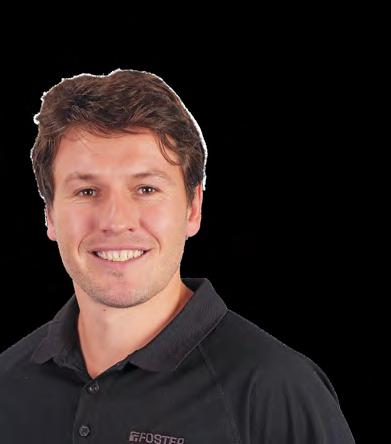
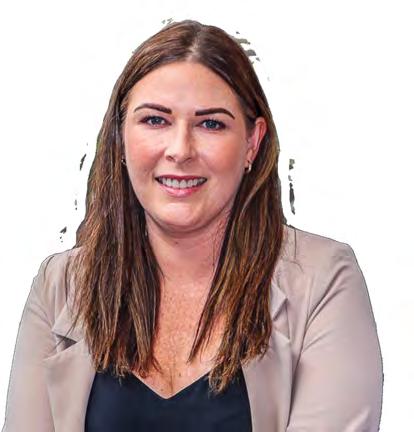
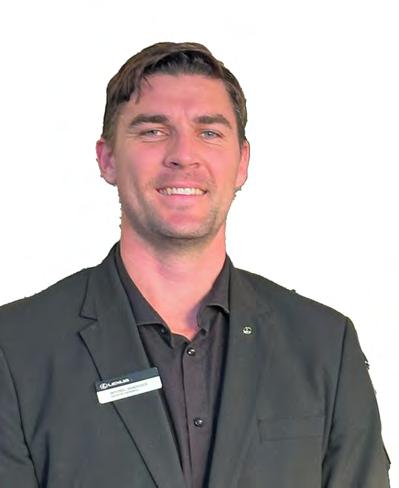
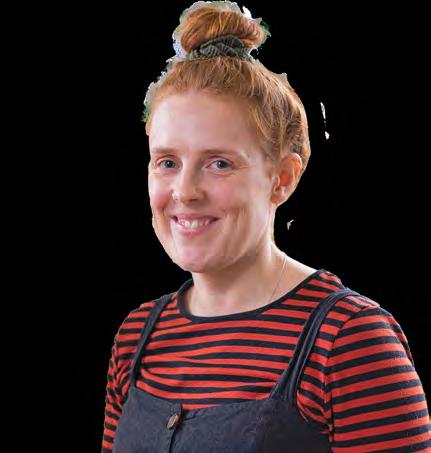
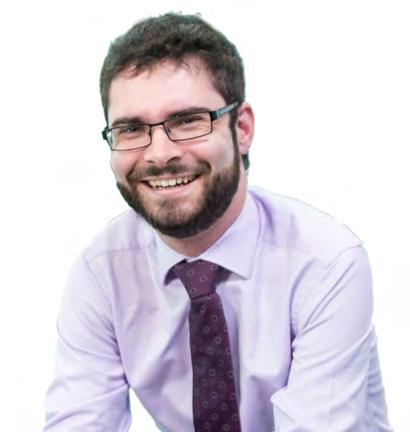
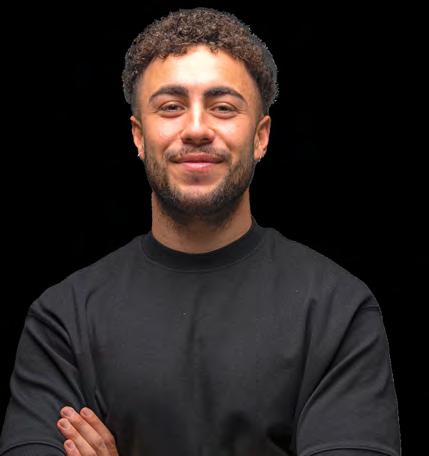
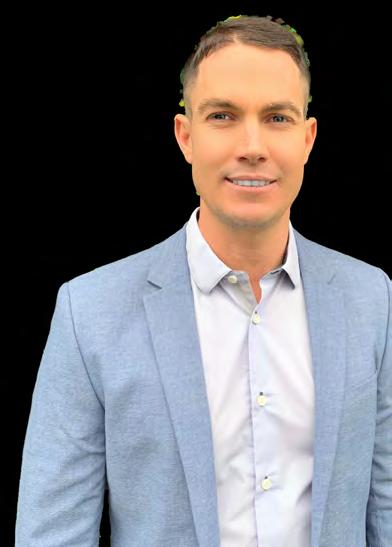
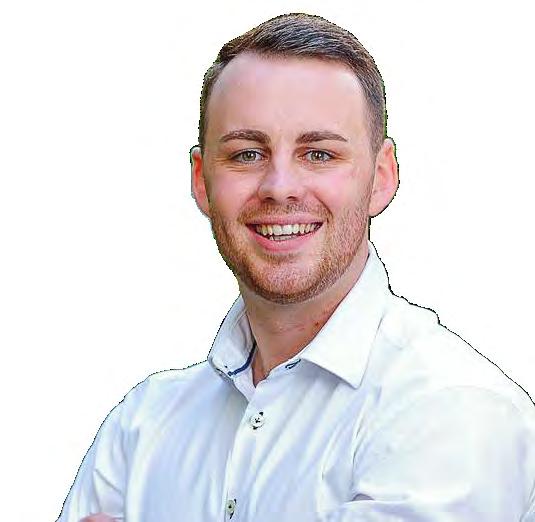
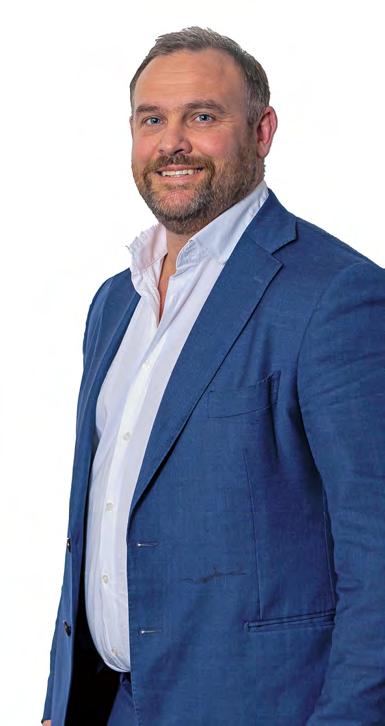
> By DAVID PORTER
Former Olympic double gold medallist rower, and now business adviser, Mahé Drysdale, recently cruised to an easy win as mayor in Tauranga’s first democratic elections in four years. He took the top spot with
16,606 votes, with a former mayor Greg Brownless runner up with 10,510 votes. They were followed by Ria Hall on 9,077 votes and Tina Salisbury with 7,388.
Former longtime New Zealand Avocado head Jen Scoular was the only female elected to the council. She reportedly said she
was thrilled, but wanted to better understand why more of the available qualified women were not elected.
“I think what people wanted was change; they just wanted local body to work in a different way,”
Drysdale told the Bay of Plenty Business News.
“We’re going to be positive and work as a team and we’re going to engage with the community and start delivering for the community,” he said. “That’s very much what I hope we can do.”
Drysdale noted the disunity and infighting that precipitated

the sacking of the ousted council. The dismissal of the previous council was announced by the then-minister of local government for the now defeated Labour government in December 2020. The Commission took up its role in early-February 2021 and was reappointed in 2022 for > Continuedonpage5

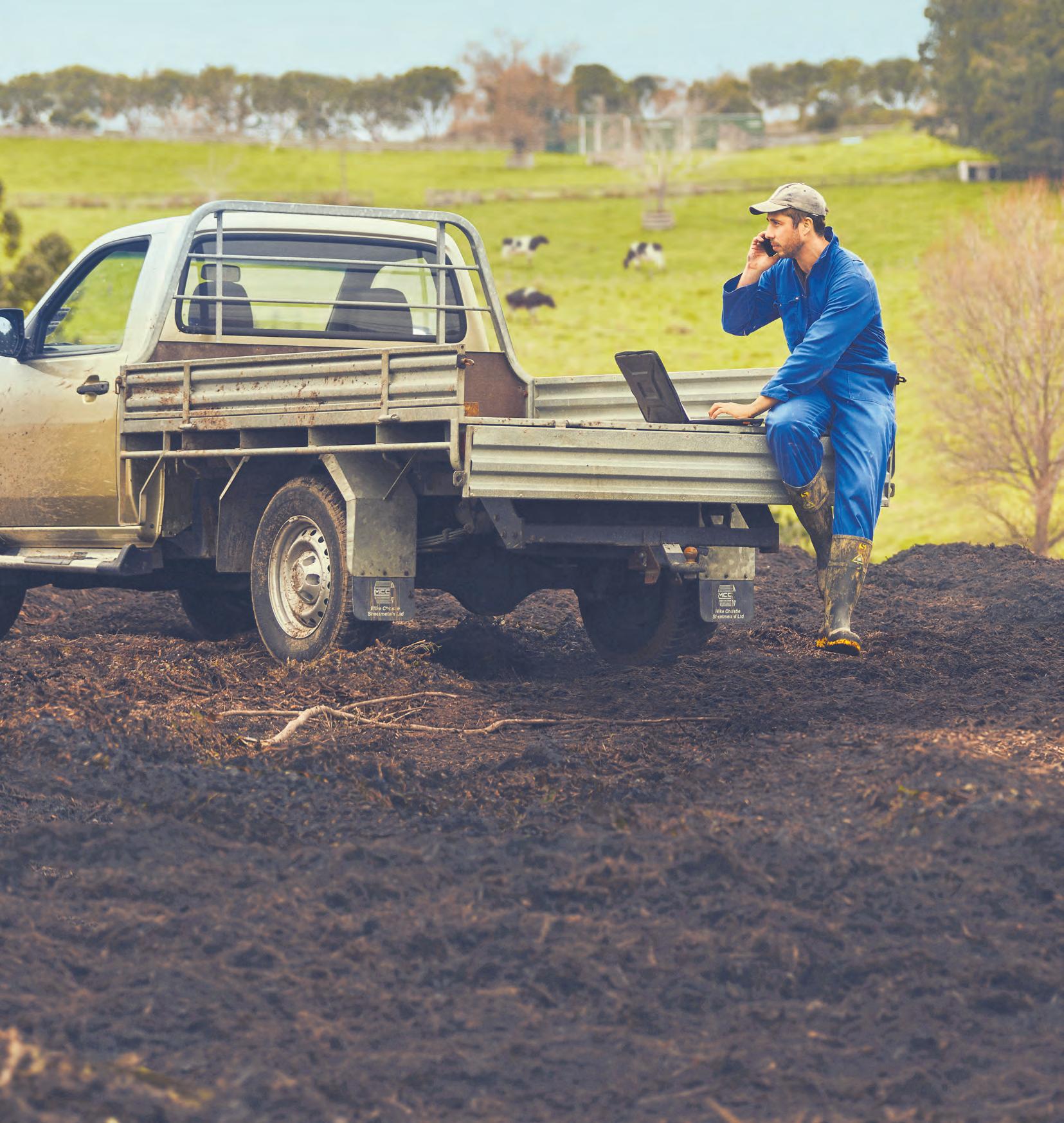
Priority One, the Western Bay of Plenty’s regional economic development organisation, is calling on central government to lead discussions with local decision-makers and business leaders to develop a joined-up strategy to strengthen the base of the Golden Triangle.
Waikato and Western Bay of Plenty regions need coordinated investment strategies alongside government, focussed onto driving our export economies, which are critical to New Zealand’s future wellbeing.
In a paper released today by Priority One and Te Waka, the economic development agency for the Waikato, the organisations outline how New Zealand’s fastest-growing regions can jointly lead the nation’s transition to a more sustainable, innovative, and productive economy through strategic inter-regional collaboration.
Priority One CEO Nigel Tutt says that the Waikato and Western Bay of Plenty are growth engines with significant untapped potential.
“As export-led economies with strong logistics connections, complementary industries such
as high-value manufacturing, energy and decarbonisation, infrastructure and life science, and comparative advantages, we have a real opportunity to accelerate economic development,” he says.
With targeted policy settings, these regions can collaborate effectively to attract investment and talent, drive innovation and export growth, and boost productivity.
Priority One advocates for central government to collaborate closely with regional and business leaders to design and implement policies based on the paper’s recommendations.
Fiona Carrick, CEO of Te Waka, emphasises the strategic significance of the regions, highlighting that Hamilton and Tauranga form two-thirds of the ‘Golden Triangle,’ which drives 42% of New Zealand’s freight and accounts for 50% of the national popula-
tion and GDP.
“We need a coordinated approach across the combined region to capitalise on the symbiotic relationship between the region’s economies, however, achieving this goal will require commitment at local, regional, and national levels,” she says.
The combined regions have experienced a 49% population increase since 2000, with Hamilton and Tauranga consistently among the fastest-growing cities in New Zealand. This growth is paralleled by GDP increases, with the Waikato seeing a 77% rise and the Western Bay of Plenty experiencing a 132% increase over the same period.
Both regions are confronted with challenges related to productivity, youth outcomes, and transport connectivity. Addressing these challenges could unlock substantial economic growth and improve overall well-being.
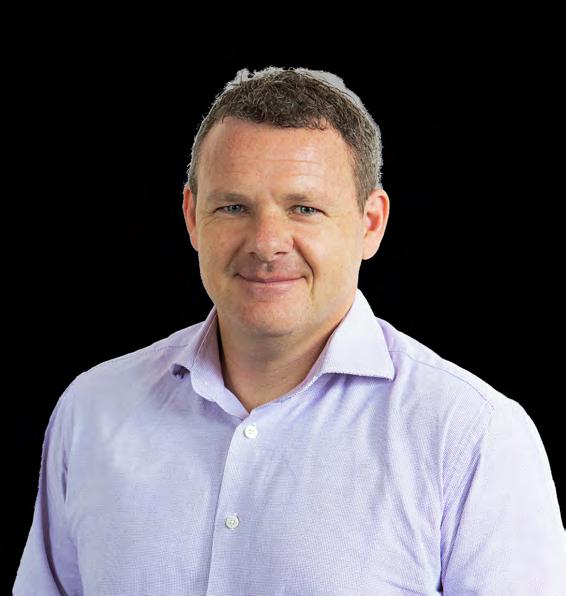
> As export-led economies with strong logistics connections, complementary industries such as high-value manufacturing, energy and decarbonisation, infrastructure and life science, and comparative advantages, we have a real opportunity to accelerate economic development.”
– Nigel Tutt

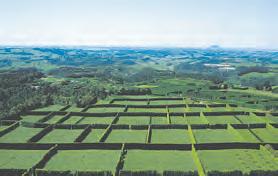
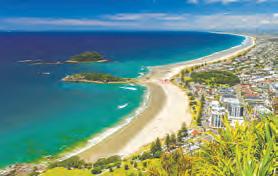
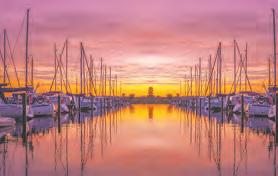
Roomforgrowth Operatingfor39years Reliabilityandqualityservice Plantandmachineryinexcellentcondition Tauranga
Thisbusinesswouldsuiteitheranexisting operatorwhoislookingtoexpandor someonenewtotheindustrywhovaluesthe opportunityofbuyinganexistingclientbase. Enquirenow!
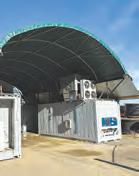


linkbusiness.co.nz/BOP00721 JamieSmith 0297702113 jamie.smith@linkbusiness.co.nz
PUBLISHER
Alan Neben, Ph: 021 733 536
Email: alan@bopbusinessnews.co.nz
EDITORIAL
Alan Neben, Ph: 021 733 536
Email: editor@bopbusinessnews.co.nz
PRODUCTION – Copy/Proofs/Graphic Design
Clare McGillivray
Email: clare@bopbusinessnews.co.nz
ADVERTISING
Pete Wales, Mob: 022 495 9248
Email: pete@bopbusinessnews.co.nz
ELECTRONIC FORWARDING
EDITORIAL
News releases/Photos/Letters: editor@bopbusinessnews.co.nz
GENERAL ENQUIRIES
info@bopbusinessnews.co.nz
Bay of Plenty Business News has a circulation of 8000, distributed throughout Bay of Plenty between Waihi and Opotiki including Rotorua and Taupo, and to a subscription base.
Bay of Plenty Business Publications 309/424 Maunganui Rd, Mt Maunganui, 3116
Bay of Plenty Business Publications specialises in business publishing, advertising, design, print and electronic media services.
> By DAVID PORTER
Ihave been a licensed motorist since my late teens and have driven without incident in much of Asia and Europe for decades. But only in New Zealand have I experienced the debilitating experience of sunstrike.
Sunstrike can occur at any time according to a New Zealand Transport Agency-Waka Kotahi (NZTA) spokesperson, but is most likely during sunrise or sunset. At those times the sun’s rays hit the driver’s windscreen at a low angle, making it difficult to see. And the NZTA advises drivers to be especially wary during winter, when sunstrike is more likely to occur because the sun is lower in the sky. Recently, it was only an alert cry from my wife that allowed me to avoid ramming the rear of a parked car in a narrow street, when I was temporarily blinded by the sun.
unaware of any research into how often sunstrike is a factor in crashes in New Zealand compared to other countries.
However, the impact of sunstrike on crashes is something that NZTA does keep a record of in the Crash Analysis System (CAS) list of contributing crash factors. (She noted that it is referenced as “dazzling sun” in CAS, not sunstrike.)
Over the last five financial years (2019/2020 to 2023/24), there were a total of nine fatalities and 94 serious injuries in the CAS where “dazzling sun” was listed as a contributing factor in the crash. That equates to about 0.8 percent of total deaths and serious injuries over this period where “dazzling sun” was listed as a contributing factor to the crash. The NZTA spokesperson noted the following caveats:
• A crash, to be recorded in CAS, must have occurred on a road, defined as any place to which the public has access with a motor vehicle.
• There is a lag from the time of a crash to full and correct crash records in CAS.
• Due to the nature of non-fatal crashes it is believed that these are under-reported, with the level of under-reporting decreasing with the increasing severity of the crash.
• The cause of a crash cannot necessarily be attributed to any one factor, as a crash may have multiple factors. NZTA offered the following guidelines:
• Be prepared for possible sunstrike when driving at sunrise or sunset, especially when turning or driving towards the sun.
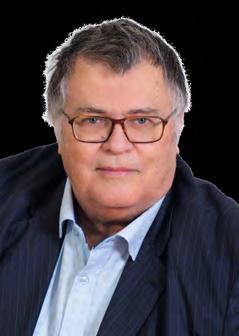
• Use your car’s visors to block the sun.
• If you experience sunstrike, it may be best to pull over and wait for a few minutes until your eyes adjust or visibility improves.

In case you missed last month’s edition Scan to subscribe

NZTA says sunstrike is not a problem unique to New Zealand. But a spokesperson advised that she was
• The data was sourced from CAS, as at 19 July 2024, based on crash factor contributing code “902: Dazzling Sun”.
• Be especially careful in winter, when sunstrike is more likely to occur because the sun is lower in the sky.
• Keep your windscreen clean of dust and grime.
• Wear sunglasses when driving with the sun in your eyes.
And an NZ Automobile Association (AA) road safety spokesman noted in an online report that it’s important to be mindful of drivers travelling toward bright, low light coming from behind you as they may be experiencing serious difficulty with their vision.
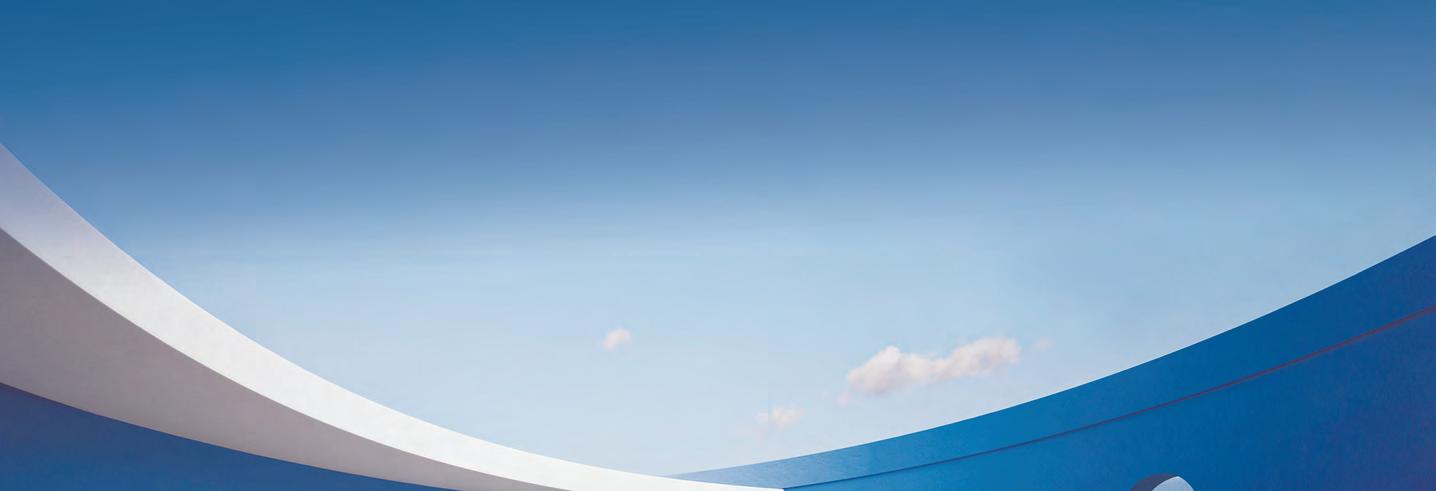


a further term, until July 2024. It ended with the new elections.
The turnout for the 2024 election saw 38.7 percent of potential voters participating, according to a council spokesman Ross Boreham. By contrast, the previous electoral vote tally percentage in 2019 was 40.3 percent.
“The result didn’t favour me, but it’s democracy and that’s fine,” Brownless told the Bay of Plenty Business News.
“[Mahé] resonated with people. They’ve got someone young and fresh.”
Brownless, who was equivocal prior to the elections as to whether or not to stand, said what finally triggered his decision was his annoyance with the commissioners and some of their actions.
These included commission attempts to, as Brownless saw it, ‘unrealistically’ propose hiking community facility usage rates, and also to propose subsidising the development of the central business area without first securing government financial support.
“We’ve got to have somebody with a bit of business sense,” he said, noting that Drysdale is a trained accountant.
Brownless was especially critical of the commissioners being able to make decisions with little of the normal democratic feedback and input of the electorate, which elected councils are obliged to observe.
“Commissions don’t have anything near the checks and balances a council has,” said Brownless. “They faced no repercussions from the community that would be worth anything.”
Brownless said he felt the new council would face issues grappling with problems over the funding of the new CBD.
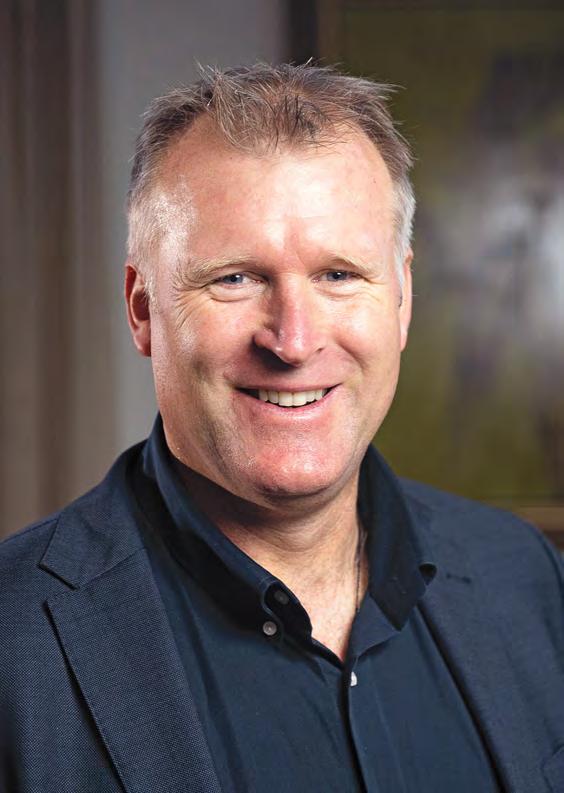
Drysdale told the Bay of Plenty Business News that he was future-focused, but had done work in examining what the issues have been in the past.
“I think that’s really important as you don’t want to make the same mistakes twice,” he said.
“They [the electorate] don’t want to see us fighting,” he said.
“They just want to see us delivering for the betterment of the city. I agree we should be debating the issues, but we need to make the decision on what is the best way forward, and back the decisions we make as
long as it’s for the betterment of the city.
“Once we’ve made a decision we’ll move on and not litigate it. That’s very much what I’d be advocating for.”
Matt Cowley, chief executive of the Tauranga Business Chamber, told the Bay of Plenty Business News he felt that Drysdale was a moderate and had good support across the community.
“There may be a tendency for some [new] members to focus on addressing their own local issues,” said Cowley, noting that in general the bar was relatively low economically for most candidates to stand.





At a planning meeting in September 2023 the Bay of Plenty Business News team decided it was time for a change – they got their heads together and decided on a fresh new look and style for the monthly business newspaper Bay of Plenty Business News.
Fast-forward 12 months and their bold decision to change format and style has been recognised by the print industry. The October 2023 edition of Business News – the first of the new-look publications – was recently awarded gold at the 2024 Pride In Print awards.

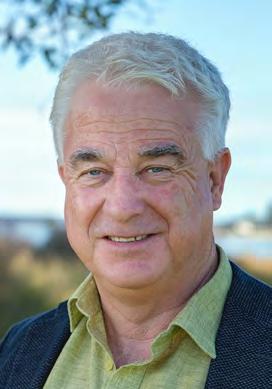
“It will take a bit of time for [some of] them to build up relationships across the community,” he said.
He pointed out that the commissioners had decided every council needed to go through a consultation process before the next election. But Cowley also noted that some of the new wards established under the former commission’s rule were not able to benefit from existing ratepayer or business associations to hold meetings and make their cases for election.
“The commissioners made their [wards] decision and it was rubber-stamped. We definitely
Publisher Alan Neben says the award is recognition of a ‘wholeteam’ approach: “Our graphic design, sales and editorial teams worked together with the printer, NZME Ellerslie, to produce a quality new-look product.
“We’re rapt with this accolade – I believe our attention to detail is what sets us apart.
“Our reputation as the region’s business voice has gone from strength to strength.
“I think we’re doing a good job and our readers and advertisers seem to agree,” he said.
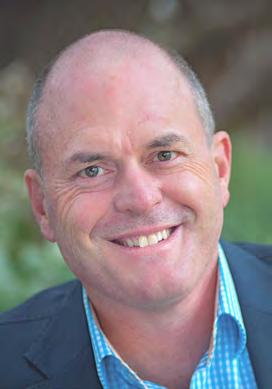
need a good debrief on whether the new ward is the right one and what is needed.”
Cowley noted that it could take some new councillors time to build up relationships across the community. And he added that he thought there was an opportunity in elections to come, to create a more in-depth, genuine debate involving candidates and electors.
Todd Muller, the current chairman of Priority One, the region’s economic development organisation, served as a National MP in Tauranga for many years before resigning and taking up his new role.
“From my own experience I found it useful to ask a lot of questions and get a sense of the challenges before I push forward,” said Muller.
He added that all the new council will be aware of the situation they are in. Central government, noted Muller, whether you were in government or in opposition, was much different to a council.
“I would hope the council look to areas that unite them, rather than those that will divide them.”
Tall Poppy is no stranger to making and standing by brave decisions. When launched in 2012, it committed to doing real estate differently and disrupting an industry in dire need of modernisation.
You might have noticed that Tall Poppy has a brand new look and is now offering its customers the choice of bilingual signs in Te Reo Māori and English. A bold new direction for the real estate agency, local business owners Janet O’Shea and Susan Northey say it reflects the Tall Poppy of today.
“Our old red poppy branding had changed four times since 2012 and no longer represented who we are and what we do,” says Susan Northey. “We’re known for fairness and delivering value, which became the starting point in designing our new brand. Since 2012, we’ve elevated what we do and how we do it, and our brand needed to grow along with us –it’s a strategic makeover that’s reshaped our identity while holding firm to the Kiwi values that drive us,” she says.
Tall Poppy’s commitment to transparency was one of the

values that initially drew Janet O’Shea to the agency. She says there are no hidden agendas or surprises when selling your property with them, which led to one of the new taglines.
“Anyone selling their property should know exactly what it will cost and what is done on their behalf at every stage, leading us to land on ‘Real Estate You Can See
Through’. This means that every step of the process is transparent for both buyers and sellers”.
Janet and Susan say the new look has been widely welcomed across the Bay.
“The best way I can sum it up is that it accurately reflects the people of Tall Poppy. Anyone who meets our team will see we are vibrant, approachable, innovative and professional in the way we deliver real estate,” says Janet.
Part of the rebrand is the choice of bilingual For Sale and Sold signs in Te Reo Māori and English, a move that’s resonated with communities across NZ – with Te Reo signs popping up in Tauranga since they were introduced a few months ago.
“It’s fantastic that people have a choice – and being the first real estate company in New Zealand to do this speaks to innovation, which is at the heart of all we do,” says Susan.

Both Janet and Susan hope the new brand will connect with people who know and are familiar with Tall Poppy and also catch the eye of people who aren’t familiar with them.
“This is just the beginning of what promises to be an exciting 12 months, especially when it comes to new technology and continuously improving the experience for our clients,” says Janet.
“Our new brand stands for excellence, innovation, and abso-
lute transparency. It also paves the way for exciting changes that will set the benchmark for excellence here in Tauranga and beyond. Watch this space!”
Janet O’Shea and Susan Northey are Principals at Tall Poppy Real Estate, Tauranga. They can be contacted: Janet O’Shea - 021 872 072 janet.oshea@tallpoppy.co.nz Susan Northey - 027 576 0499 susan.northey@tallpoppy.co.nz
James & Wells is pleased to share that partner Tonia Brugh has been recognised by NZ Lawyer as one of New Zealand’s most influential lawyers in 2024.
Tonia was nominated in the ‘changemaker’ category, a prestigious recognition that highlights the significant impact Tonia has had in the intellectual property profession. The changemaker category recognises lawyers who have been leaders, innovators or catalysts for positive change in
any area of the profession.
Tonia spent her formative years growing up in Rarotonga, Cook Islands and is passionate about supporting Pasifika and Māori entrepreneurs in her work. She is an advocate of te reo Māori and tikanga and assists a number of Māori Boards in a pro-bono capacity, as well as acting as Co-Chair on the Pacific Island Community Tauranga Trust (PICTT) and supporting her esteemed Trustees at Te Murumāra Foundation (Te Aka Māori Dictionary).
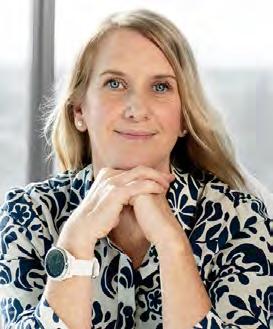
Tonia weaves her Pacifika background and culture into her unique way of working with her clients. She focuses on long-term connection and relationship building, placing people and connection at the forefront of everything she does. Tonia walks with her clients for their whole journey – she works to empower her clients to succeed on their own merit and supports them along the way.
Tonia is a dual qualified trade mark and intellectual property specialist, with over 20 years of
domestic and international experience advising clients in this area.
Tonia also has experience in entertainment and IT practice, including drafting, reviewing and advising on a wide range of agreements for publishing companies, recording artists, song writers, authors and film production companies. Tonia also offers specialist IP expertise in indigenous rights, privacy, data protection and sovereignty as well as commercial contracts.


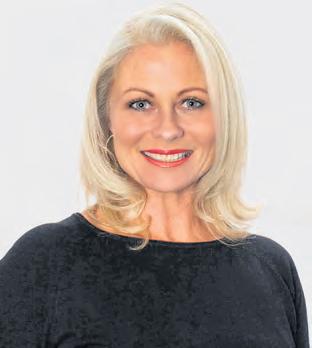

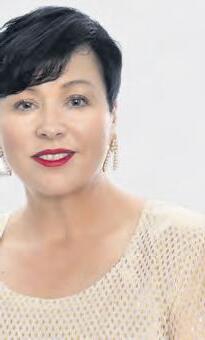
Tauranga office workers are being encouraged to ride like Jason Momoa and beat the traffic using Vallkree e-bikes endorsed by international celebrities including Momoa, Kelly Slater and New Zealand’s own Tiki Taane.
Mt Maunganui-based entrepreneur Dan Wallace has brought Vallkree to New Zealand to redefine our e-bike market which he says has been dominated by over 50s riding recreationally.
Vallkree bikes have been loaned to staff at BECA, Priority One, and Datacom in Tauranga where they are encouraging their staff to rethink their commute and use their e-bike to get to work. The bikes are also available through WorkRide. The scheme supports employers to purchase bikes, e-bikes, or scooters on behalf of staff members and lease them to their employees. The employee pays the bike or scooter back over the following year through pay deductions.
“We want to redefine how Kiwis perceive eco-friendly commuting. The rest of the world is just destroying New Zealand with green initiatives. I have lived 14 years overseas, and if you go anywhere in Europe, everybody’s got a
commuter e-bike in their garage,” says Dan.
“Traffic in Tauranga is dire, and we need more people commuting. These bikes are designed with style in mind. They can cover about 50km on a single charge and reach speeds up to 40km/h,” says Dan.
Vallkree e-bikes was founded in 2012 by Japanese-Australian surfer Terumi Iwagami, who designed them to skip heavy traffic in Byron Bay town and speed straight to the surf. The brand’s commitment to sustainable transport has garnered a global following, attracting the attention of icons like Kelly Slater and Jason Momoa, who endorse Vallkree bikes as their ride of choice, and now New Zealand’s own Tiki Taane.
Dan has 10 distributors nationwide, and aside from their vintage-inspired design the bikes are also unique in New Zealand because they can be ordered online and shipped directly to customers.
Vallkree models like the Moon
Dog can also take multiple passengers, with spacious seating and cargo racks, making them ideal for families, couples, or anyone seeking a stylish alternative to traditional transportation.
“Vallkree are the first e-bikes in New Zealand that Kiwis can get shipped directly to them and assemble. We know Kiwis are still averse to buying big-ticket items online which is why we’ve kept distributors too. People can also get their bike sent to the distributor to assemble,” says Dan.
Vallkree bikes also stand out for their customisation options, offering a wide range of colors and configurations, from sleek black to vibrant pink.
“We’re thrilled to bring Vallkree’s bikes to New Zealand, offering consumers a sustainable and stylish alternative to traditional transportation. Our directto-consumer model and customisation options mean Vallkree is poised to revolutionize the way Kiwis commute,” says Dan.
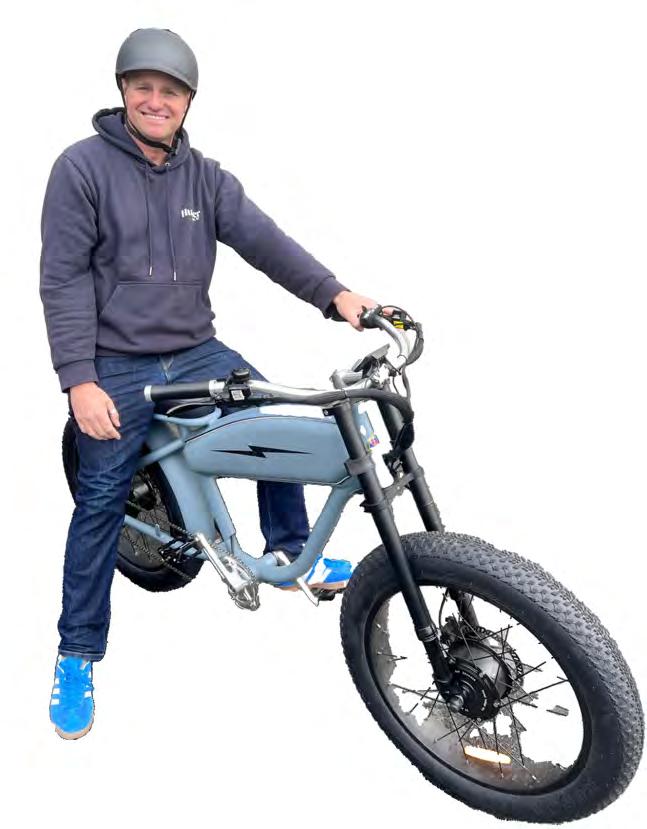
MtMaunganui-based entrepreneurDanWallace
When Space X introduced Starlink, it was groundbreaking technology, but there were few local use cases to back up the effectiveness of the solution.
FletcherTech, Fletcher Building’s technology division, teamed up with 2degrees Business to tackle significant connectivity challenges faced in remote locations across New Zealand and Australia.
“Being relatively straightforward and cost-effective to trial, soon after Starlink was first available, we ordered several and put them into sites where networks were not reliable,” says Grant Ivory, GM Technology Operations and Service for FletcherTech.
FletcherTech was impressed with initial results. The Starlink service far surpassed 4G’s ability to carry business-critical network traffic when lines went down.
“Providing all Fletcher Building businesses reliable and consistent coverage is imperative to FletcherTech,” explains Grant. “For this reason, we gen-
erally put fibre into our sites with mobile network serving as a failover.But fibre install lead times can take months to a new greenfield site or may not even be available and 4G is not always available in very remote sites either.”
After canvassing in-region network providers, FletcherTech engaged 2degrees to assist with governance, and 2degrees assisted in managing deployment, maintenance, and support for the growing fleet of Starlink devices.
Starlink equipment is now an integral component of Fletcher Building mobile site offices for roading and other projects. It is a rapid deployable solution for network redundancy and surpasses the capability of most other available mobile networks.
• Flexibility and responsiveness
With around seven hundred sites, some of which are tem-
porary or mobile sites or geographically challenging, the ability to quickly deploy highspeed, low-latency connectivity is invaluable. FletcherTech uses Starlink for its enterprise systems as well as communications and collaboration. When sites are connected, people can work productively and effectively.
• Connectivity performance Starlink offers download speeds and latency needed for business-critical applications. And uplink speeds that can carry video communications and enterprise application traffic to keep business running smoothly.
• Adaptable business cases
Establishing immediate connectivity is an obvious business case for FletcherTech. When Cyclone Gabrielle took out sites across New Zealand’s East Coast, the 2degrees Starlink service reestablished communications overnight FletcherTech uses Starlink in greenfield residential sites under development. Site connectivity is established in days,
faster than the extension of domestic fibre networks. A further business case is the deployment of Starlink as an integral component of mobile roading site offices.
• Governance and support Procuring Starlink directly from SpaceX is incompatible with governance policies and can lead to ‘shadow IT’ outside the control of the central IT function. Procured via 2degrees, enterprise contracts and associated financial arrangements (in this case, lease) and Service Level Agreements make Starlink for Business a suitably governed and managed solution for FletcherTech.
• Affordability
Where a fibre link might cost anywhere from tens to hundreds of thousands of dollars to deploy, a 2degrees Starlink for Business connection is a few hundred. With leasing options, FletcherTech can deploy Starlink to many sites across New Zealand and Australia cost effectively. Not only is connectivity to the individual sites highly cost-effective, but their
value multiplies as the equipment is mobile and can power temporary sites or rapidly establish emergency connectivity when and where required.
• Results
“If our sites don’t have connectivity, systems stop working – and that can cost thousands daily,” says Grant. “Sites without good internet are now a thing of the past. Starlink is dependable, cost-effective, flexible, and backed by 2degrees. It has all the governance and security you would expect from a corporate connectivity solution.”
“Starlink affords a huge advantage for business continuity and disaster recovery. Working with 2degrees has been a great experience driven by a can-do attitude.”
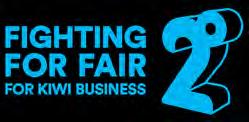
Find out more about Starlink for Business at www.2degrees.nz/ business
Life can be uncertain and sometimes things can go wrong. Having an emergency fund is one of the most essential financial practices you can adopt.
It is an amount of cash that you know you have relatively quick and easy access to when you need it. An emergency fund can help you prevent debt or tapping into your savings when you face a sudden and unexpected financial challenge, giving you the confidence of a security net for stressful moments that you may face in life.
By having an emergency fund, you don’t have to rely on credit cards, loans, or other forms of borrowing to cover unexpected expenses, avoiding the risk of falling into a debt trap.
This isn’t to be confused with a rainy-day fund, an emergency fund is not a luxury, but – ideally – a necessity. A rainy day fund is for impulse purchases, spur of the moment getaways, or helping friends or relatives in need. On the other hand, an emergency fund is for safeguarding your financial stability and well-being in times of crisis.
Instead of cash is king, think cash management is king. An adviser can create strategies for your cash management ensuring you do the best that you can. You might be pleasantly surprised by what options are out there for you such as high yield savings accounts and Cash PIE funds. The money is not helpful to you if you can’t access it in a time of emergency, so these are not funds to invest in long term fixed products or growth assets.
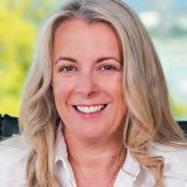
BY SARAH ASHBY
Some emergencies that people may face include medical emergencies, sickness or harm, losing income, or sudden geographical events that create financial difficulties. While you might have insurance for some of this, it may not be adequate to fully replace what you have lost.
You can also use your emergency fund as a buffer for your budget in times of hardship and adjust your spending and saving habits accordingly. This can help you stay on track with your financial goals, such as buying a home, paying off debt, or retiring early.
An easy way to estimate how much should be in your fund is to ask yourself how much would you need to get by for three to six months if you were suddenly unable to earn your income?
Three to six months’ worth of expenses is a common rule of thumb, but it can be different for everyone. Setting up a fund with any amount is a step in the right direction.
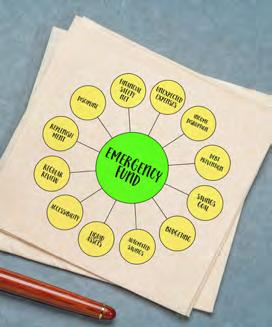
Everyone! If you don’t have one, and you’re able to, you should make it a priority to start building one. Peace of mind alone is reason enough to start building. Having an emergency fund is the first step to strong financial wellbeing.
Once in place you can start to think about short term and even longer-term goals. You will have peace of mind that you can start to consider volatility and creating growth because you will know that you will have funds to fall back on.
If you want to build a solid financial foundation, start by setting up an emergency fund today.
Working out a budget, settling on a realistic amount, committing to regularly transferring surplus, and removing visibility of the account from internet banking so you’re not tempted to touch it. This will give you the security and confidence to face any challenge that life throws at you.
Sarah Ashby is a Wealth Management Advisor at Jarden. She can be contacted on 07 222 0674 or 027 211 0760 and Sarah.Ashby@jarden.co.nz
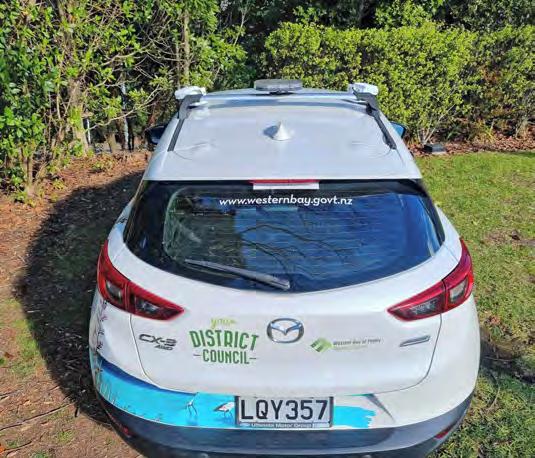
Roving parking cameras are being trialed in Katikati and Te Puke, to see if they would be of benefit to the Western Bay District.
The three-month trial, by Western Bay of Plenty District Council, will use the License Plate Recognition (LPR) system, which is already used by a number of councils, including Tauranga City Council.
The high-resolution cameras will capture licence plates and GPS locations of parked cars, to identify those that have parked for longer than the designated time limit, or that are parked illegally, for instance on yellow lines. No tickets will be issued as a result of the trial.
Council is exploring the technology for a number of reasons, says Sophie Scholes, Council’s Team Leader Compliance Support.
“In recent years we have seen an increase in aggression towards parking officers. The cameras would allow them to do their job safely, without having to leave the car,” she says.
Another safety consideration is drivers causing hazards by parking where they shouldn’t, she adds.
“Parking on yellow lines outside schools at drop-off and pick-up times is a growing problem.
The LPR system would help identify who is parking on the lines and act as a deterrent for unsafe parking.”
It would also encourage a greater turnover of car parks in the town centres, which would benefit shops and businesses.
“During the trial we will be collecting data and analysing it to see whether this is something that could help us keep a closer eye on parking and make our towns both safer and more accessible,” says Sophie.
“You can expect to see our car around town, with two cameras on top, over the next 12 weeks, but we won’t be issuing any tickets for vehicles caught on camera. If we do decide to go ahead, following the trial, we will give people plenty of advance warning.”
Tauranga has elected a new, 10-person Council, with Mayor Mahé Drysdale now going through the process of determining positions of responsibility, including the deputy mayor and committee chairs, as well as the committee structure.
Those decisions will be confirmed by the Council at its first official business meeting on 15 August.
Mayor Drysdale says he feels humbled by the community’s support for him and for the nine successful ward candidates.
“In most cases, the electorate’s decision has been clear cut, so we can now get on with the job of taking Tauranga from good to great and making it the best city in New Zealand.”
He says his first task as Mayor will be to form a strong governance team which can “hit the ground running” and ensure that the potential of the city is realised, for the benefit of residents and the wider region.
“The voters have clearly said that they want a positive future for Tauranga, so it’s now our
responsibility to make democracy work, for everyone. We have made some great strides under the guidance of the Government-appointed Commission and we need to maintain that momentum and continue the job of creating a vibrant, progressive and future-ready city.”
Mahé says collaboration with the business community will be a key focus. “I see engagement with all sectors of the community as an absolute must, because we have to know
what our stakeholders want so that we can deliver on their priorities.
“Making it easier for business to succeed is one of those priorities, because that’s how Tauranga will succeed. The Government is looking at a range of legislative reforms to address some of the obstacles that are slowing New Zealand’s progress and I’m keen to continue that work at a local level. While we have to protect the environment that makes Tauranga such a great place to live, we also need
to do that alongside ensuring that we have sensible rules that allow our productive and housing sectors to ‘do the business’.”
He adds that the relatively low voter turnout at the just-completed election is a concern. “People underrate just how important local government is in their everyday lives. We do need to ensure that the community becomes more engaged in future Council processes, so that will also be something for the new governance team to turn its attention to.”
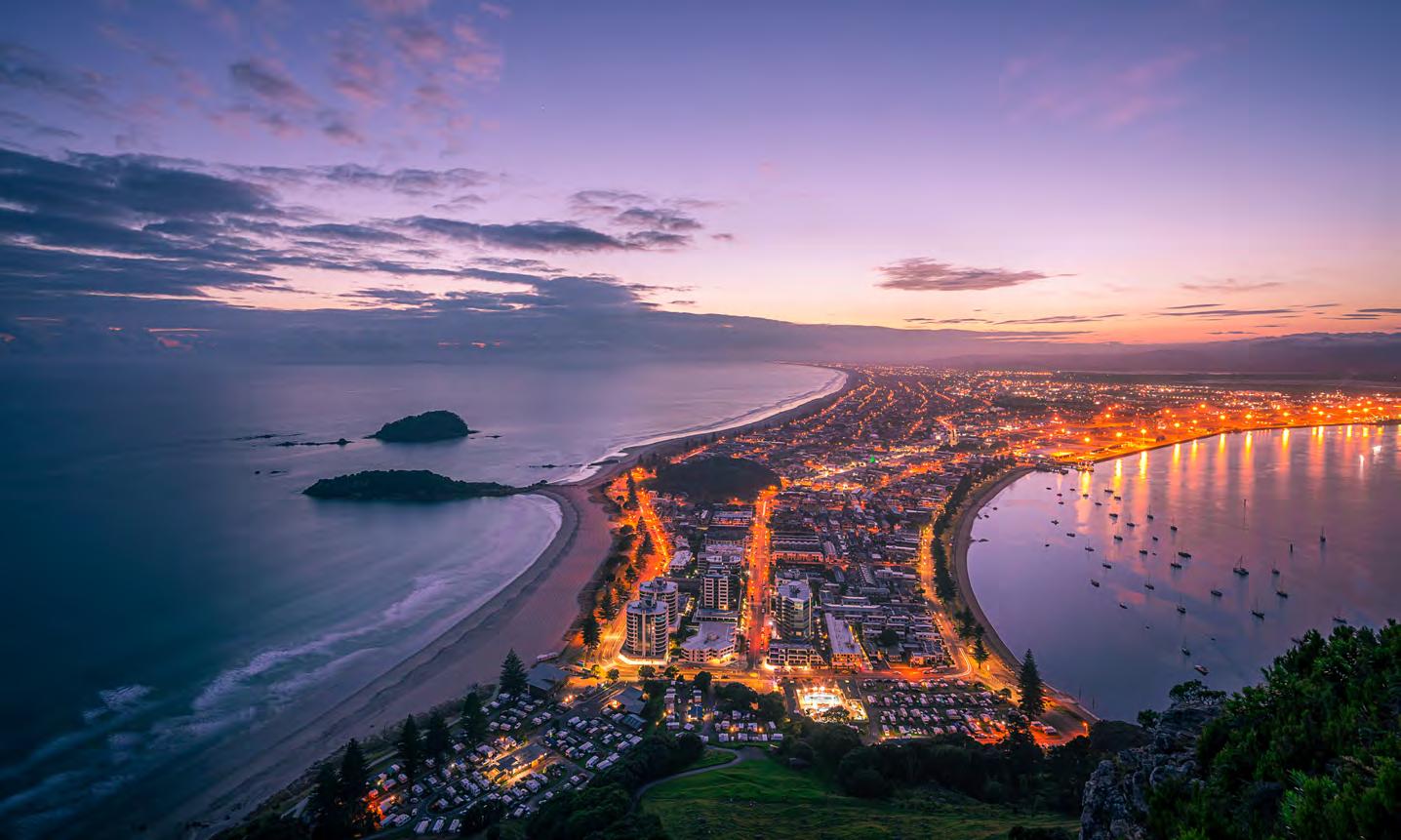
The stories behind the people in this month’s business Under 40s lineup are many and varied. We reached out to the business community and asked them to tell us about the new generation of personnel in their organisations who are really making a difference?
The feedback was immediate. This year we again struck gold with a crop of exceptional individuals at all levels of business from all types of organisations.
At a time when so much business attention is focused on the challenges of the economy and epic global events, it is refreshing to read their stories.
We spoke to a range of people from a cross-section of industries – the takeout message for us: despite current business challenges, the future of Bay business is definitely in good hands.
As every business owner will tell you, bringing an idea to life takes time, money, and an enormous amount of energy. There is little more rewarding than seeing your idea turn into a commercial success, but all too often, we see others try to capitalise on that hard work.
George Jackson has been protecting the intellectual property rights of Bay of Plenty businesses for several years. “Good products, reputation, and brands are important to any business. If you are successful, you are at risk of imitation. Too often we see people trying to skip the hard part by copying a proven success.”
As a member of James & Wells’ commercial team, George advises on and prepares agreements to best secure his client’s commercial position. “When I work with clients, I want to ensure the best outcome for them. A key part of that is truly understanding their objectives so that I can provide them with commercially relevant, pragmatic advice.”
A specialist in copyright, trade marks and fair trading matters, George is no stranger to intellectual property disputes. His time in the Tauranga District Court gives him affinity for research and preparing written material.
George’s work isn’t limited to SME
businesses. Working with James & Wells, NZ’s largest independent intellectual property firm, has seen him involved with large international corporations.
“The most important thing any business can do is to protect their ideas right from the very start. Whether that’s securing your trade mark, or patenting your invention, it is much easier to enforce your rights if you engage with an IP specialist from the beginning.”
James & Wells has been protecting intellectual property for New Zealand’s brand owners and innovators for more than 40 years. Their depth of experience ranges from managing large IP portfolios
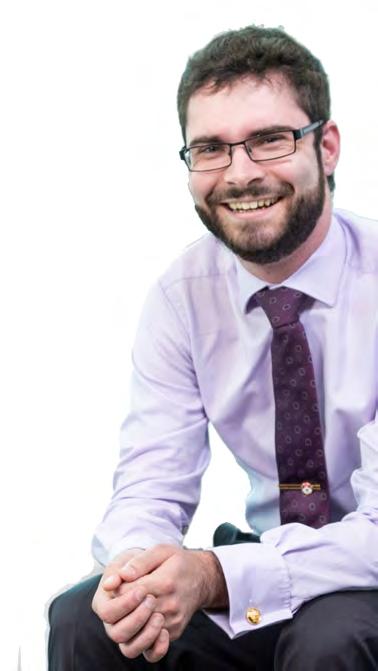

Tom Rutherford, representing the National Party, serves as the Member of Parliament for the Bay of Plenty and is the youngest MP of any of the Government parties.
His political journey stems from a desire to serve his local community, in which he was born and raised, and help tackle some of the biggest challenges the community and country is facing at the moment.
Despite his youth, Rutherford brings a local perspective, energy and fresh insights.
Rutherford has a degree in Public Policy and Political Science
and prior to his parliamentary career, he worked for the Mayor of Rotorua, Tania Tapsell, in the Policy and Planning team at the Western Bay of Plenty District Council and for the National Party.
When he’s not at work, Rutherford enjoys spending time with his fiancée, Hannah, playing cricket for the Greerton Cricket Club, officiating as a New Zealand Hockey Umpire and Bay of Plenty Rugby Referee, and he recently retired as a volunteer firefighter with the Mount Maunganui Fire Station, after 3.5 years of service.
In his maiden speech to Parliament, Rutherford pledged
to address key concerns for the Bay of Plenty, such as the cost of living, crime, and infrastructure, particularly advocating for the upgrade of State Highway 29 over the Kaimai Ranges and the Takitimu North Link all the way through to Ōmokoroa.
As a new MP but a lifelong local in the Bay of Plenty, he brings a contemporary perspective and emphasises active listening and humility in public service.
Committed to building on past efforts, Rutherford aims to contribute to New Zealand’s progress for future generations.
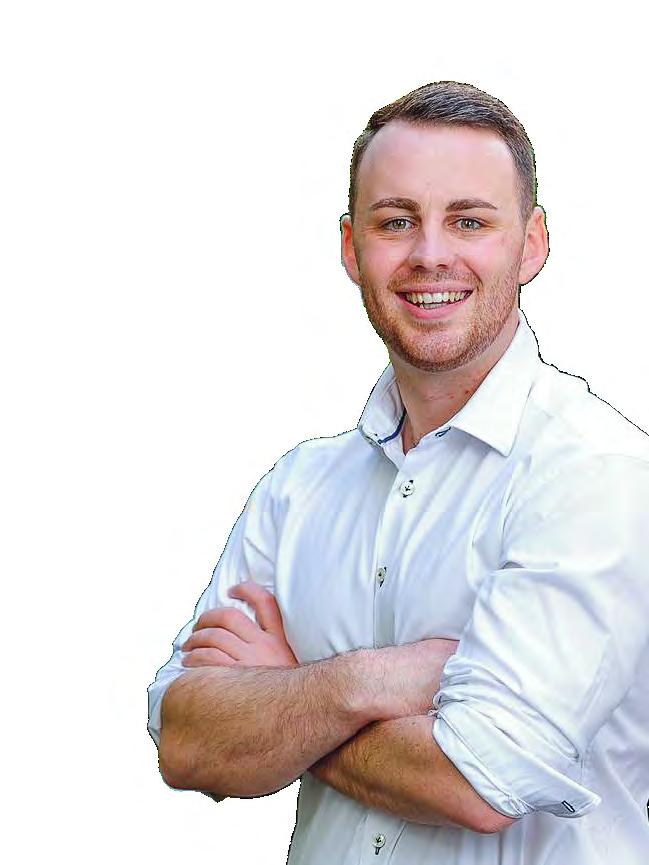

Lexus has always been determined to treat customers better than any other luxury car brand. At the heart of this is an ancient Japanese concept called Omotenashi which is a principle that describes one’s ability to anticipate the needs of another, even before they arise. Omotenashi means we focus less on comparing ourselves with competitors, and more on creating amazing experiences and developing long lasting relationships that put us beyond comparison.
Since opening in June 2021, Lexus of Tauranga has upheld this principle in the Bay of Plenty and is proud to say it leads the Lexus network in customer satisfaction.

Leading the way for Lexus sales is
With a history in hospitality while studying a marketing major at the University of Waikato, Mitchell developed skills that became a natural fit for the Lexus brand and its customers. These skills were refined after accepting a position into the prestigious Toyota Dealer Graduate Program with Toyota New Zealand, a program that accelerates future leaders within the dealer network.
Driven by passion, Mitchell Handcock is a true car enthusiast. “I love the Lexus brand; it’s at the forefront in many ways technologically, which means I’m often introducing people to their first experience driving a hybrid,

plug-in hybrid or electric vehicle”. Mitchell emphasizes the customer journey is crucial, “With Lexus, the customer service doesn’t stop once the handover is complete. If anything, it has only just started as it continues throughout their ownership experience”
For the second year in a row, Lexus New Zealand set a new sales record in 2023 and is on target to surpass it this year. “We have lofty goals, to be the number one luxury automotive brand and we are making significant progress, not only nationally but in the Bay of Plenty as well.” With 90% of Lexus’ 2023 sales being electrified, the brand targets a younger demographic than ever before, introducing all-new models like the Lexus LBX.
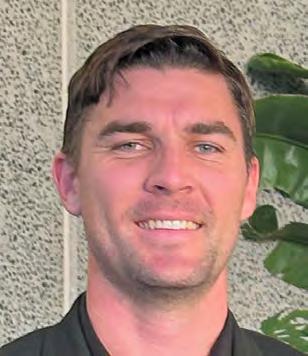
Customers are initially attracted to the superior hybrid technology but ultimately choose Lexus because of the Omotenashi principles that ensure an unparalleled ownership experience. As Lexus of Tauranga continues to grow, Mitchell Handcock remains dedicated to making luxury personal, one customer at a time.


An ongoing interest in construction and seeing the positive change it can have on communities is what attracted Ryan Edgar to the construction industry. Now, just over 15 years into his career, he’s a lead project manager and shareholder in Foster Construction BOP Limited.
Ryan started on the construction pathway with a Bachelor of Surveying from the University of Otago. He then spent 10 years working overseas – specifically the United Kingdom and Australia – in project management roles for infrastructure and commercial construction projects. He returned to New Zealand in 2021, settling in the Bay of Plenty and joining Fosters.
Loyal, hardworking and a natural leader, Ryan embodies ‘The Fosters Way’. “I am driven by leading and collaborating with teams towards a common goal and delivering a high-quality product for the client. Something I enjoy about Fosters is their focus on good relationships being a key to success, they place high value on client and sub-contractor collaboration,” says Ryan.
Similarly, the Fosters’ purpose, which is to create built environments where community can thrive, aligns well with Ryan’s initial attraction to the industry. “The Village Ōmokoroa is a good example of the way construction can bring a community together. It’s something that Fosters does exceptionally well” he adds.
In addition to The Village Ōmokoroa, other notable projects that Ryan has worked on include Prahran Square, which transformed an old car park into a dynamic and inviting public space, and 510 Church Street, a commercial office development –both in Melbourne.
He’s currently leading the Metlifecare Somervale Village redevelopment. An ambitious project, targeting a 7 Homestar rating, it was begun in August 2022. Fosters are building an amenities block, featuring 30 apartments, a pool, gym, cafe, salon, activities room and more. With sustainability being key, it involves new materials, and innovative construction methods. More importantly, notes Ryan,
it will serve as a new community hub for the Somervale Village.
Currently working on his MBA through Waikato University, Ryan is focused on furthering his education in business management and leadership.
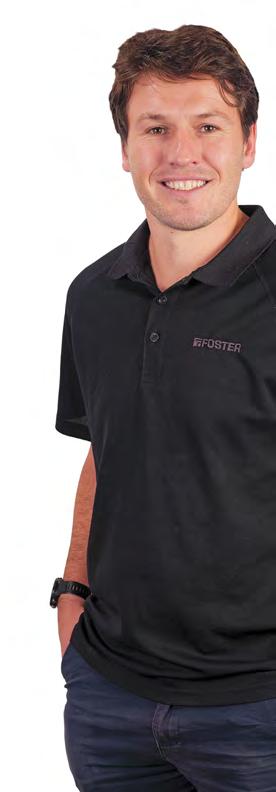
Born and bred in Tauranga, Tom Elvin understands the significant growth opportunities for the region.
As a Tompkins Wake Partner in the firm’s commercial practice, Tom specialises in general commercial work, commercial property, Agribusiness and day-to-day small to medium enterprise needs. “I have a deep understanding and appreciation for our unique community,” Tom says. “We are not a small coastal town anymore, we’re innovative, hardworking, and a smart city.”
What sets Tom apart is his transformational approach to
client relationships. He brings tremendous energy, experience, and enthusiasm to his work, ensuring that his connections with clients are genuine.
His client base, which includes large commercial entities and families as well as cross-border (international) clients and local authorities, mirrors the vibrant and diverse Bay of Plenty community, to which Tom is deeply committed. “I view each relationship as an opportunity to foster growth and transformation, aiming to build lasting, trustbased partnerships.
Tom is passionate about the thriving start-up ecosystem in the

Bay of Plenty, helping founders and entrepreneurs structure their businesses for long-term success.
Tom also dedicates time to governance roles serving as a trustee for numerous private trusts and is the current Chair of Sport Bay of Plenty.
“For me, it’s all about creating a positive impact both within and beyond the legal landscape of the Bay of Plenty. Tauranga is our home. It is where Sara and I have chosen to raise our family. It is a great place to live, work and do business.”
Tom Elvin | Partner tom.elvin@tompkinswake.co.nz
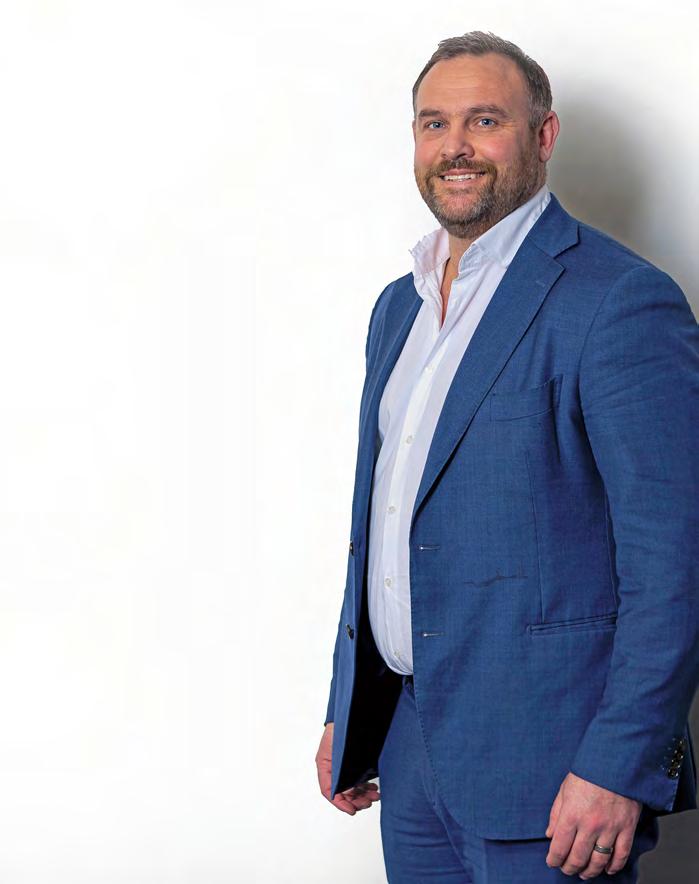

Working with local business owners and senior leaders to lift their organisations to new levels of success is Maryse Dinan’s passion.
Maryse is the Icehouse Regional Lead for the Bay of Plenty and the first point of contact for anyone wanting to access the support and expertise of New Zealand’s leading business growth hub.
The Icehouse has been lifting the capability of Kiwi SMEs since 2001 with offices throughout the country and a co-working hub in Parnell. In Tauranga, the office is located at the Basestation.
The Bay of Plenty region has a strong Icehouse alumni base with over 180 businesses benefiting
from Icehouse programmes, coaching and networks. Working with well-known Icehouse facilitator Jamie Brock, Maryse has been instrumental in bringing programmes to the region including the Bay of Plenty Business Owner Programme (for businesses between $1-3M) the Emerging Leaders Programme and Financial Skills Workshops, all held in Tauranga.
Maryse hosts regular events for the local business community with a recent session at alumni business Likeable Lab kicking off a regional scholarship opportunity for local business owners to join the Owner Manager Programme (for businesses with revenue of $3M +). She is the powerhouse behind strengthening strategic
partnerships with stakeholders, including BNZ Partners and the team at the Regional Business Partner.
Maryse has a background in business having worked in organisations across several industries including agriculture, tech, training, and print. She has delivered results in different capacities for the Icehouse in the past, returning to the organisation after a two-year break and now stepping up to a newly created senior role.
“The people I work with are all highly-motivated owners or leaders in businesses but a few younger owners that stand out in our regional alumni network are Lauren McAuslin from McDonalds,
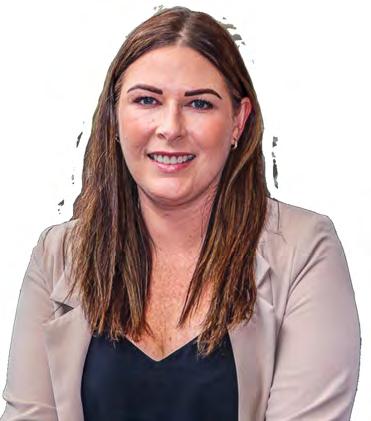
Ray
Our alumni are getting younger and more diverse. We now have 28% of our Owner Manager Programme under 35 and in the Bay of Plenty almost 30% of our alumni are women, which is above the national average.
m.dinan@theicehouse.co.nz
Brendon Lee, Mpac Group’s dynamic Managing Director, brings over two decades of experience in the kiwifruit industry.
Since joining Mpac Group in 2012, Brendon has been a driving force behind the company’s strategic growth and operational excellence.
Brendon was an integral part of the development of Mpac’s cutting-edge post-harvest facility, transforming it into a benchmark for the industry. His hands-on approach from concept through to detailed design, construction, automation and implementation has set a new standard in postharvest efficiency.
“What I find most rewarding is the challenge each season brings and the continuous pursuit of better results for both the growers and the company,” says Brendon.
Under his leadership, Mpac has remained at the forefront of post-harvest innovations, with a focus on ensuring top-notch quality outcomes for Zespri and unwavering support for their growers. His attention to detail and commitment to quality have instilled confidence in their partners, demonstrating Mpac’s dedication to their success.
Mpac’s state-of-the-art facilities, has significantly increased industry capacity, allowing for
more flexible harvesting and streamlined operations. The further addition of five million trays of static Coolstore capacity for the 2025 harvest is a testament to Mpac’s continued forwardthinking approach.
Brendon values the collaborative spirit of his team, taking pride in both individual contributions and collective progress. His leadership has been pivotal in driving Mpac Group’s continued success and innovation within the kiwifruit industry.
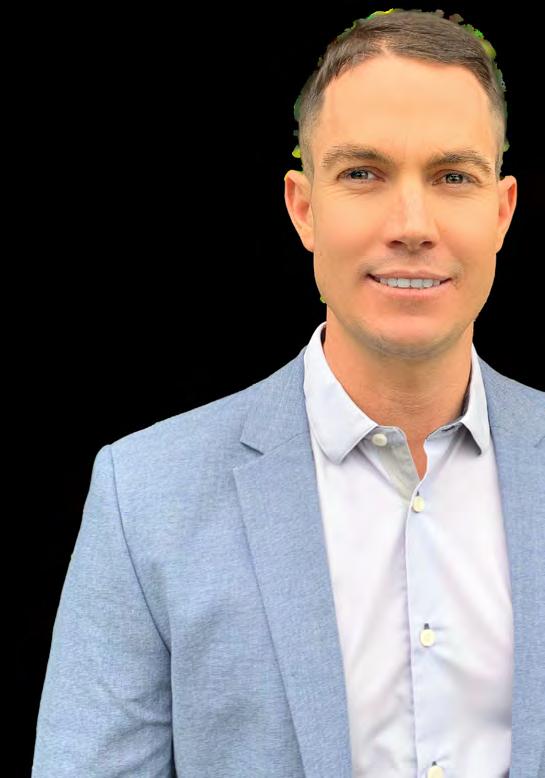

Lily Ivana is a creative force, blending her roles as a visual artist and a key contributor to Creative Bay of Plenty’s mural project in Tauranga’s city centre. Her mixed media and acrylic works are a testament to her creative prowess, while her part-time role with Creative Bay of Plenty underscores her commitment to enhancing public spaces. Currently, she is undertaking a stocktake of walls suitable for large-scale murals in Tauranga’s CBD, a project that highlights the intersection of art and community.
Growing up in Holmfirth, a Yorkshire town famous for the sitcom “Last of the Summer Wine”, Lily’s artistic journey began early. She pursued a BA in Art and Design at Leeds College of Art, followed by a BA Hons in Decorative Arts from Nottingham
University. After a brief return to her hometown, she set off on a life-changing adventure to Aotearoa, eventually settling in Mount Maunganui. What was initially a year-long plan turned into over seven years, and she now calls Pāpāmoa home, living with her partner, her son, and their dog, Sally.
Lily draws inspiration from diverse sources, including the ceramics of Grayson Perry, the art philosophy of Victor Vasarely, and the humour of comedian Katherine Ryan. These influences shape her artistic vision, infusing her work with depth and character.
For Lily, art is a tool for expression and mindfulness, a sentiment that guides her creative and community endeavours. Her advice to aspiring creatives
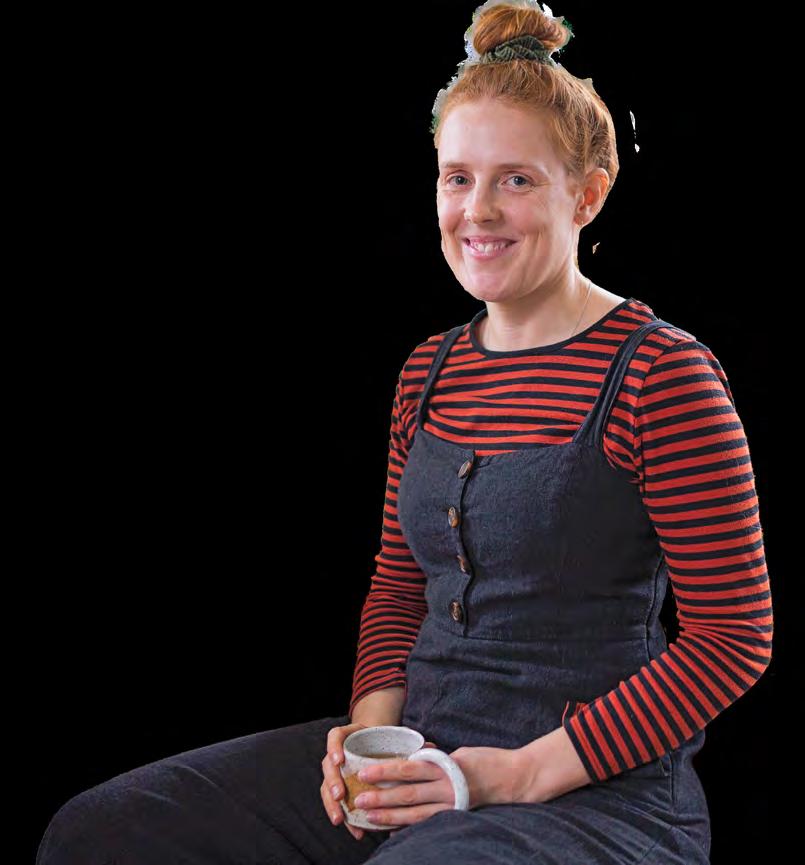
Max Yeager (Ngāi Te Rangi, Ngāti Ranginui, Ngāti Whakaue) runs Māngai Media, a small Māori owned business here in Mount Maunganui. Max has a background in marketing and communications and in 2018 he graduated with a Business diploma in Marketing, Communications & Sales from Waikato University.
After finishing high school Max’s path wasn’t clear and like many other young people growing up, he wasn’t sure of what he wanted to do. While finishing his Diploma with Waikato University, he was also interning at a well-established PR agency here in Tauranga Moana. This opportunity allowed Max to develop what he had learned while studying and apply it in real scenarios.
Over his internship Max was able to work across a wide range of businesses and brands in the Bay of Plenty and the wider New Zealand which opened his eyes to how everything really worked. Max found it valuable being surrounded
by people who had a wealth of knowledge in the marketing world and over his time working there he was able to take small bits of Mātauranga and add it to his kete.
For as long as he can remember Max has been passionate about creating things. While growing up, Max’s would always be filming the kids on her VHS Camcorder, which was the top of the line camera back in the early 2000s. Max remembers playing around with it one day and being absolutely fascinated with it, filming random stuff and getting super excited watching it back. Those early memories of messing around with that camera led Max into picking it up later on.
Music has also been a big part of Max’s life. He’s played guitar since he was young, always participating in kapa haka “whether I liked it or not” and when he reached high school his friend introduced me to a software called “FL Studio”, a digital audio workstation (DAW) that lets you create, mix, and produce music with a range of built-in sounds, instruments, and
effects all from your laptop. Max started messing around with that and fell in love. Fast forward to now he has worked with MultiPlatinum, Grammy Nominated artists from across the world. Max’s life bounces between both the film & music space which go hand in hand with each other.
Māngai is a creative hub driven by Mātauranga and Tikanga Māori, and over the past few years Max has worked with brands, businesses and artists who are really good at what they do.
A whakatauki Max really admires is “Ka Whati te tai ka pao te tōrea” – much like the saying ‘strike while the iron is hot’, if Max is presented with an opportunity he will do his best to act on it straightaway. So far this year he has worked on two documentaries, shot a music festival, and worked on two major albums for International artists in the US.
Max’s ancestors were natural storytellers, creatives, entrepreneurs and problem solvers. He draws inspiration from

them and tries to channel it into the work he does today.
The New Zealand economy started 2024 on a weak footing and the outlook for the second half of the year remains challenging. This downturn is leading to inflationary pressures, high interest rates and our unemployment rate, continuing to climb at 4.3%, is expected to hit 5% by the end of the year.
Despite rising unemployment, skill shortages are still evident across a range of sectors. Sourcing candidates with the right skills and qualifications is still proving challenging for employers from different industries in this ever-evolving business landscape.
The appeal of higher salaries and greater opportunities abroad, especially over the ditch in Australia, continues to draw Kiwi talent away. In addition, with a global shift in relation to working remotely from home and offshore, many New Zealanders have the opportunity to work for internationally recognised companies, whilst residing locally.
A recent study by Statistics
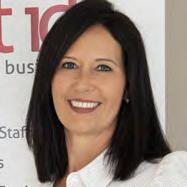
BY KELLIE HAMLETT
NZ, identified that 52,500 citizens left New Zealand from April 2023 – March 2024, with more than two-thirds of these jetsetters being under the age of 45 (many of whom make up the skilled talent base that our country desperately needs). Immigration is simply not supplying the critical talent that our employers need.
In short, although there has been some loosening of the employment market, it’s still far from easy. There are still significant skill shortages throughout
several sectors with a slight ease of market conditions masking the reality of the situation.
In a market such as this, it makes good business sense to be laying some foundations for future growth, and in terms of employment, one of these areas is in determining your employer value proposition (EVP). How a company markets themselves to prospective talent, and also how key talent is retained, are both key aspects of your EVP. Consider what your business offers over other organisations? Why should your organisation be an employer of choice for talent and what value will that bring?
Having a robust reputation as an employer goes beyond attracting the best employees to your vacancy – it will provide positive opportunities and financial advantages to your company. Engaging and ultimately retaining talented staff saves your business money.
Employees that stay with your company can be trained
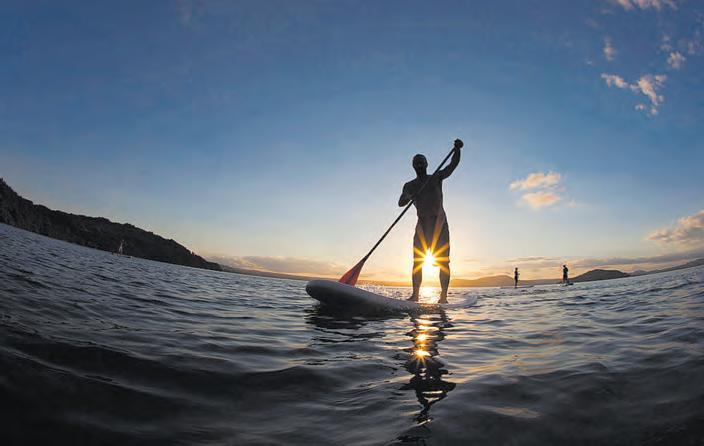
and developed retaining essential skills and knowledge. Do you know the real cost of having to replace an employee in a key role who has been with your company for several years and is leaving to work for a competitor?
Some of the ways in which you can look at enhancing your employer brand include adopting Equal Employer Opportunity practises, community involvement and engagement, flexibility with work options, environmental and sustainability policies, providing a point of difference as an employer from your competitors, real benefits, genuine commitment and care of your employer brand through company integrity and leadership.
Do you know what your employer brand is – how your business is perceived by those not in the marketplace but those who are already working for you? Starting in-house with an initial employee survey could be the first step in researching current perception and what you might take
on board as feedback to improve your employer brand for the future.
Acknowledging that this is an incredibly difficult time for many in business, and businesses are surviving in the best way they can, hiring for the inevitable recovery may not be an option, however working on your people strategy is.
Progressive businesses who continue cultivating a motivated, productive workforce through developing their EVP will no doubt add value to the business in the years to come. Talent ID is here to support you to navigate your way through this downturn and help New Zealand businesses develop skills and capability they’ll need for the workforce of tomorrow.
Talent ID are Recruitment Specialists and can support you through your recruitment process. Please feel free to talk to us about this by calling 07 349 1081 or emailing kellie@talentid.co.nz









It’s no secret that one of the best ways to learn is to learn from others.
Just as amateur sports players can learn how to improve their game by watching the professionals compete, or by reading articles detailing their training and nutrition, nascent businesses can also learn from other businesses that have already achieved certain successes.
But outside of publicly listed companies — typically huge corporations that may not have a lot in common with an emerging business — it can be difficult to find good information on small businesses that your business can learn from.
This is one of the reasons Deloitte runs its annual Fast 50 programme, which celebrates and ranks New Zealand’s fastest growing companies, recognising businesses that have experienced substantial revenue growth over the last three to five years.
This showcase of commercial high performance aims to encourage innovation and entrepreneurship, create networking opportunities, attract investment,

BY ANDREA SCATCHARD
and ultimately further economic development in New Zealand.
Past Fast 50 winners have gone on to become some of New Zealand’s most iconic businesses and greatest success stories, but their growth journeys are often less than straightforward. Each year our Fast 50 businesses are generous in sharing their stories, their successes, their mistakes and their challenges. From this, we are able to gain valuable insight into the
key issues facing New Zealand’s fast-growing businesses, which we share within our Fast 50 e-zine, Insights from Innovators.
The 2023 indices revealed some notable year-on-year changes. Historically cited by business owners as the primary obstacle to growth for Fast 50 businesses, talent shortages were joined by regulation, along with access to capital and rising interest rates.
Within this challenging economic climate, our 2023 Fast 50 businesses were able to flex and adjust, and even for some, to thrive, with last year’s winner, NFT and digital collectables company Veve Digital, achieving a mammoth 1239% revenue growth in the three-year period to 2023.
While start-ups and emerging businesses should rightly be focusing their energy and resources on creating a profitable enterprise, they don’t want to have all their good work undone
by non-compliance with domestic and overseas tax obligations. Nor do they want to find out that the trading structure that was set up at the start is no longer fit for purpose or does not easily cater for the growth experienced.
Are
meeting your tax obligations?
Getting expert input at the beginning of your journey, from an adviser that has the experience and ability to cost efficient advice appropriate for your age and stage of operations, will be money well spent. You only have to look at the level of liquidations instigated as a result of overdue tax debt to see how quickly tax debt can get out of control.
Now into its 24th year, the Fast 50 is back for 2024 and is looking for Kiwi businesses, especially those based in the Bay of Plenty, who are pushing the limits, breaking records, and redefining fast growth. Learn more and submit
> We are hosting a Fast 50 information evening in conjunction with BNZ at their Partner Centre in Tauranga on Wednesday 7 August and we would love to see you there to answer any questions you have.
your entry at https://bit.ly/3y4KcpS. Entries close 5pm, Friday 30 August.
We are hosting a Fast 50 information evening in conjunction with BNZ at their Partner Centre in Tauranga on Wednesday 7 August and we would love to see you there to answer any questions you have. Secure your spot at the event here: https://bit.ly/3YegDga
Andrea Scatchard is a Tax Partner at Deloitte, based in the Bay of Plenty. She can be contacted on ascatchard@deloitte.co.nz

Franchising offers a structured approach to establishing and running a business. It’s well-documented and statistically proven that franchising reduces the risk associated with being in business. Franchise businesses generally have a high success rate compared to independent businesses.
However, not all franchise businesses within the same brand experience the same level of success. This disparity can often be attributed to varying locations, markets, competitive sets, and economic conditions. Yet what happens when the same location or territory is operated by different franchisees with vastly different outcomes?
Many franchisors can recount instances where a well-performing business either excelled or declined significantly under new ownership. The franchisee is a crucial component of the threelegged stool of franchise success. In fact, research indicates that the franchisee factor is the single
largest contributor to success. If you’re considering becoming a franchisee, there are three essential questions you need to answer to determine if a particular opportunity is right for you. Essentially, you need to assess how you measure up in three critical areas.
Is the brand the right opportunity for me?
There are numerous questions within this category. Start by asking yourself if you can envision yourself as part of the brand. Do you understand what is expected of you and what successful franchisees in the brand do on a dayto-day basis? Would you be happy performing these tasks every day?
It’s crucial to understand what success looks like within the brand. What kind of money are successful franchisees making, and is this in line with your expectations?
Like any relationship, a mis-
alignment of expectations cannot be overlooked and will ultimately lead to dissatisfaction and failure.
Can I learn and implement the required skills?
Every business demands a specific set of skills, whether it’s making coffee, building a fence, or discussing finance options with a potential client. You need to take a realistic and honest look at yourself and ask, “can I learn those skills?”
Maybe you already possess the technical skills and see a franchise as a way to utilise those skills and build a business. This can be a path to success, but it also presents challenges. One critical aspect is being coachable. Can you accept guidance from the franchisor and their team? Can you work within the system?
Many technically skilled people, who should theoretically succeed within a franchise, do not
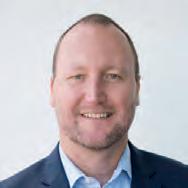
BY NATHAN BONNEY
because the brand isn’t the right fit for them, or they are unable to be coached and work within the system.
Finally, and perhaps most obviously, you need to consider if you can fund the franchise. This question is often not fully thought through.
Instead of merely asking, “Can I fund the setup and purchase?”,
you need to consider two additional questions: “What is the range of time I can expect to reach cash-positive or break-even status?”, and, “Can I sustain or fund myself during this period?”
These are crucial considerations that will determine your financial viability within the franchise.
Franchising offers a promising path for many aspiring business owners, but success is not guaranteed. By carefully evaluating the brand, your ability to learn and implement required skills, and your financial preparedness, you can better position yourself for success within a franchise system.
The franchisee’s role is pivotal, and understanding and preparing for these critical areas can make the difference between success and failure.
Nathan Bonney is a director of Iridium Partners. He can be reached at nathan@iridium.net.nz or 0275 393 022
Change sucks! Nothing is going to be the same again! The world as I know it is ending! ... all thoughts that have flashed through my mind at various points in my life. Change is draining; I think I have life all sorted out and then something happens to knock me off course.
When my glass is half empty, this is how I feel. I’ve lost control. Change is owning me. My life is being dictated to me by others and by circumstances beyond my control. It’s debilitating and paralysing.
All pretty negative stuff. Thankfully, these feelings and thoughts don’t last too long, even in the face of quite dramatic change. I’m not going to pretend I have all the answers, but what I have come to realise over the course of my life and career is that change is an inevitability. I have a choice: I can embrace it and either drive it or roll with it, or I can sit back and let it happen to me.
I’ve tried each of these strategies (and I appreciate that even with the most positive of mindsets you can’t control everything) but I much prefer taking charge of a situation so I jump at any opportunity to get involved with

TECH TALK
BY MIKE BELL
new things that can have a positive impact on my life. From a business perspective this more positive philosophy is evidenced every day in companies that we all recognise as industry and sector leaders across the globe. Whilst I loathe the phrase, why do we set so much store in being able to ‘pivot’ in the face of a changing business landscape, financial conditions or
customer need? Because, being adaptable is acknowledged as a huge strength that can unlock new opportunity and success even in the most challenging of commercial environments.
Why do we talk of the next ‘disruptor’ in our particular industry with so much reverence? Because we all understand that, far from this being a negative influence, this dramatic change will be something positive that will ultimately lead to new, significant and exhilarating opportunities.
It is the catalyst for potentially huge growth and those who actively seek out this type of positive change quickly take on and evolve these new initiatives and concepts ensuring their businesses thrive.
This might all seem a bit deep for a Tech Talk column, but if you’re a regular reader, you’ll know that new technology is changing both our work and personal lives at a phenomenal pace.

So, we need to take a bit of time to establish what that means for us as people, because ultimately, technology is here to enhance our lives – not to make them meaningless.
Our worlds are changing, jobs are changing, and new opportunities and challenges present themselves every day. We all need to decide what that means for us. Do we control the narrative of our own lives and businesses, or do we let the narrative control us or try to resist the inevitable?
So, whilst I have blatantly stolen an R.E.M. song title for my
headline, partly because I have very fond memories of it, it’s also because the sentiment behind it is as true today as it was back in 1987. Life moves so fast, the world as we know it ends every single day in some way, shape or form. But tomorrow (and for the next few billion years at least) the sun will rise and a world full of new opportunity will present itself ... and I’ll feel fine. Will you?
Mike Bell is the CEO at Stratus Blue. He can be contacted at mike@stratusblue.co.nz
The ways we work and the ways we learn are changing and in this rapidly evolving world, ākonga (students) at Toi Ohomai Institute of Technology are gaining exciting real work experience in their chosen industries.
We are all aware of the important role that education plays in our communities, particularly the transformative impact that gaining relevant skills and qualifications has for not only individuals but their whānau, their workplaces and those around them. With five main campuses across the rohe, our commitment to regionally responsive education and training is at the heart of everything we do. Through vocational education our ākonga are given unique experiences enabling them to confidently enter the workforce, with the skills employers need.
We see examples of this across our range of courses, and recent highlights include a new partnership with Tauranga City Council who recently installed 100 sea pods as part of a living seawall on the Tauranga Waterfront. This is the first of their kind in
New Zealand and the pods are uniquely designed to attract tidal plants and marine animal life.
Our ākonga, Abby McDonald, will work with scientists from Toi Moana Bay of Plenty Regional Council and the University of Waikato to monitor the progress of this initiative.
In June our Culinary Arts ākonga were invited to assist with the prestigious Tohunga Tūmau Puanga Matariki Dinner. These ākonga worked alongside some of Aotearoa’s top chefs for this unique showcase of the country’s finest Māori food, beverage, entertainment and culinary arts.
We were able to leverage the recent MEETINGS tradeshow held in Rotorua to enable our hospitality, event management and tourism students to gain an insight into business events.
Ākonga not only got to experience and explore the MEETINGS tradeshow, but they attended ses-
sions designed to develop their knowledge and understanding of the business events industry.
This enabled them to understand how their specific areas of study play a part in the overall business events ecosystem, as well as showcasing potential career pathways.
It is experiences like these that demonstrate the critical role that tertiary education plays in supporting our local industries. By developing tailored educational programmes and providing quality training, we ensure that our ākonga gain the skills and knowledge needed to thrive in these sectors.
Close collaboration with our industry partners is a cornerstone of this approach. We work handin-hand with local businesses to develop curriculum that reflects current industry practices and future trends. This approach, alongside quality industry expe-
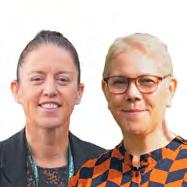
BY HUIA HAEATA AND KIERAN HEWITSON
rience, not only enhances the employability of our graduates but also drives innovation and growth within the region.
Toi Ohomai also recognises that Māori play a pivotal in regional social, environmental, and economic development. In this regard, we work closely with Tiriti partners to ensure that we respond to the needs of and improve outcomes for Māori learners, whānau, hapū and iwi, and employers. With our focus on empowering communities through accessible and inclusive education, we
are committed to providing equitable opportunities for all members of our community – enabling education for everyone.
The future of tertiary education in the Bay of Plenty and South Waikato is bright. We are committed to continuously evolving and adapting our offerings to meet the changing needs of our region.
This requires ongoing dialogue with Tiriti partners, industry, community leaders, and students to ensure that we remain responsive and relevant.
Ultimately, our vision is to create a learning environment that empowers individuals, strengthens communities, and drives regional prosperity.
By working together and staying true to our values, we can achieve this vision and make a lasting impact on the Bay of Plenty and South Waikato.
Kieran Hewitson and Huia Haeata are Tumu Whenua ā-Rohe 2 Regional Executive Directors for Toi Ohomai Institute of Technology. www.toiohomai.ac.nz 0800 86 46 46
What is a sale and leaseback?
Many New Zealand businesses own their work vehicles, financed by either paying with cash or using other lines of credit.
The smart decision however is to lease these depreciating assets off FleetPartners and invest the surplus funds that are released to generate more profit in the business.
FleetPartners Sale and Leaseback programme is a straight-forward and practical pathway to delivering working capital back into the business, whilst also de-risking the fleet for the future by having FleetPartners manage all aspects of the fleet going forward.
A switch to leasing your fleet also frees your staff up from the day- to-day administrative burden of looking after work vehicles (servicing, repairs, WOFs, registration, RUCs, replacement tyres, windscreen repairs).

Here’s how a sale and leaseback works
FleetPartners fleet experts will engage on a no obligation basis with any business that owns its vehicles outright or has vehicles under finance. We can work with just one vehicle through to a significant fleet.
We will undertake an assessment of your current fleet by gathering vehicle registrations, models, age, kilometres travelled, any fitted accessories and more.
We’ll gain insight into your business, discuss how your fleet is utilised and find out how your fleet can help achieve your
business goals. Your goals may include objectives such as to replace aged vehicles with the latest vehicles choices, reduce costs, reduce emissions, comply with health and safety, or improve efficiencies generally.
FleetPartners then carry out a free fleet assessment and then deliver you a formal proposal to consider. This proposal will determine the economic and fitfor-purpose life left in each of your current vehicles along with a suggested course of action to mitigate risks and maximise fleet utilisation and efficiency.
This proposed plan may include a programme to swap out
aged vehicles over the set timeframe, with associated financial impacts.
FleetPartners will then present a financial offer to purchase your fleet based on either current market value or your book valuation.
Once we agree on a purchase price, funds will be paid to the business in a lump sum within an agreed timeframe. The offer will include lease terms on the fleet which may vary from vehicle to vehicle, depending on the age and mileage and your business goals.
FleetPartners total solution includes the ongoing management of the fleet, which will be leased either via a Fully Maintained or a Managed Maintenance Operating Lease. This means you can roll out one fleet policy to your drivers and your vehicles will be managed by fleet experts ensuring safety and cost controls are in place.
Customers will also enjoy access to fleet specialists who will provide tailored guidance on their fleet strategy, keeping up to date with the latest industry

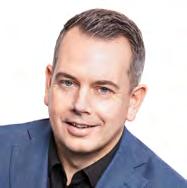
trends and information, while accessing benefits such as relief vehicles, discounted fuel cards and accident management.
If you are looking at your company car park and seeing only owned depreciating liabilities, talk to us to convert it to cash.
To find out more –– visit the www.fleetpartners.co.nz website or call 0800 438 435.
Clayton Coe is the Regional Sales Manager, Customer Relationships & HCV at FleetPartners. He can be contacted on 0272 718 758 and clayton.coe@fleetpartners.co.nz

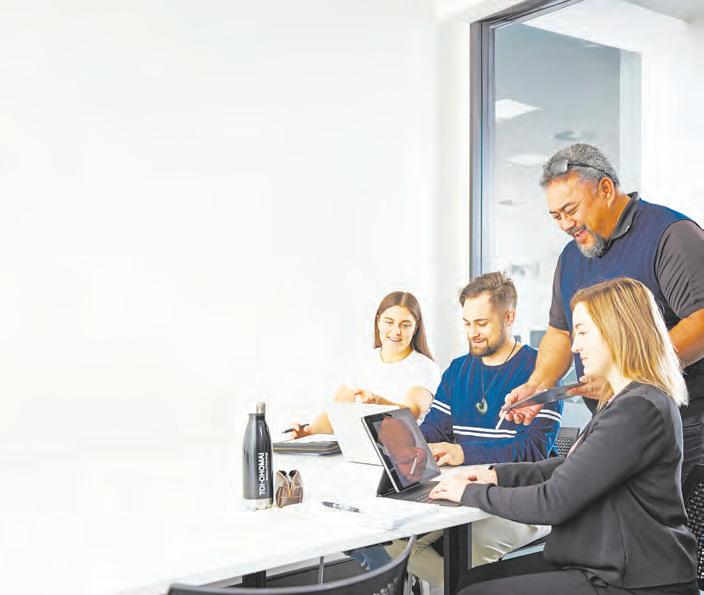
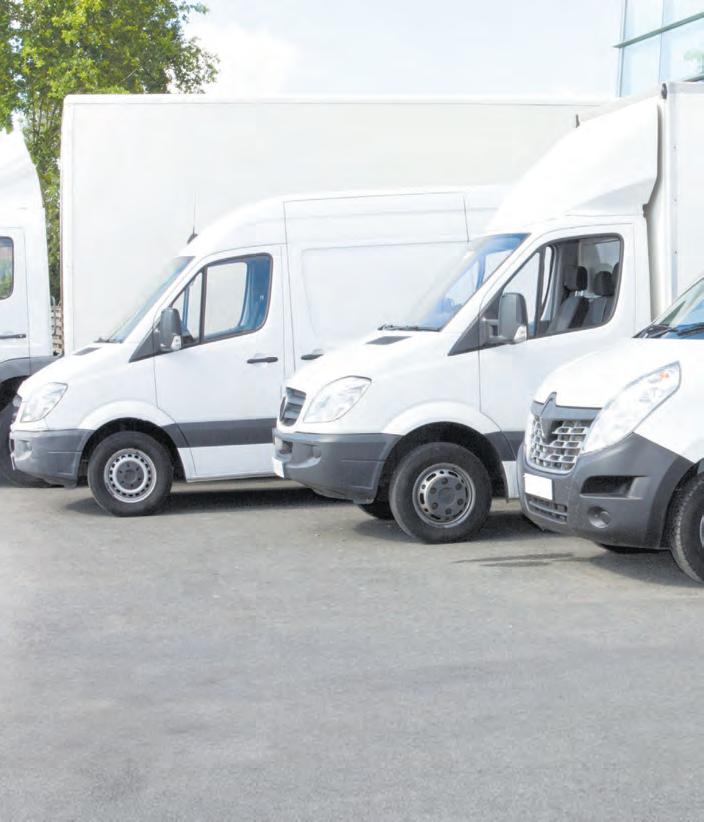
Just 12 months after its official opening and having already won numerous design awards, Rotorua’s luxury lakefront spa, Wai Ariki Hot Springs and Spa, has been nominated as a finalist at the World Architecture Festival (WAF) 2024.
Designed to combine Rotorua’s natural geothermal resources with traditional Ngāti Whakaue wellbeing practices, the unique spa will now go up against some of the world’s most innovative projects in the WAF Completed Buildings – Hotel and Leisure category.
The winners at the world’s largest architecture awards will be announced in Singapore in November.
Developed by Pukeroa Lakefront Holdings Limited (PLHL) and designed by RCG, Wai Ariki Hot Springs and Spa has already hosted thousands of manuhiri (visitors) since it opened in June last year.
PLHL Chairman, David Tapsell, is proud of the international attention Wai Ariki is receiving and says to be shortlisted is already a win for everyone involved, including PLHL, the Wai Ariki team, spa manager Belgravia, designers RCG, Ngāti Whakaue, and the wider Rotorua community.
“Wai Ariki lives and breathes through an innovative, authentic design that’s specific to our rohe,
envisioned by the minds of Ngāti Whakaue mana whenua, and delivered by Kiwi architects. This latest recognition places it on a pedestal in front of the world,” Mr Tapsell says.
“We are proud to deliver an experience that is tightly woven with who we are as Ngāti Whakaue, and to be able share our unique heritage and manaakitanga with the world in this way. In turn, we are extremely proud of the future outcomes it will deliver for our whānau, both now and into the years ahead.”
Inspired by Ngāti Whakaue cultural narratives, the physical design of Wai Ariki is infused with local whakairo (Māori carv ings) and designs, while reflect ing the volcanic colour palette of the surrounding rohe.
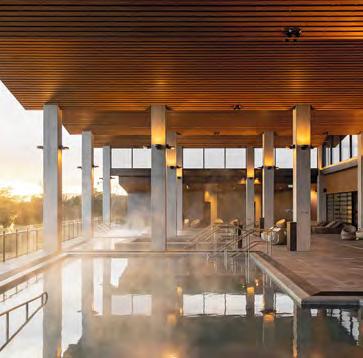
Wai Ariki Hot Springs and Spa General Manager, Debbie Robertson, says the building itself is an important part of the Wai Ariki experience, highlighting and reinforcing the Ngāti Whakaue legacy.
“Our spa experiences are inex-
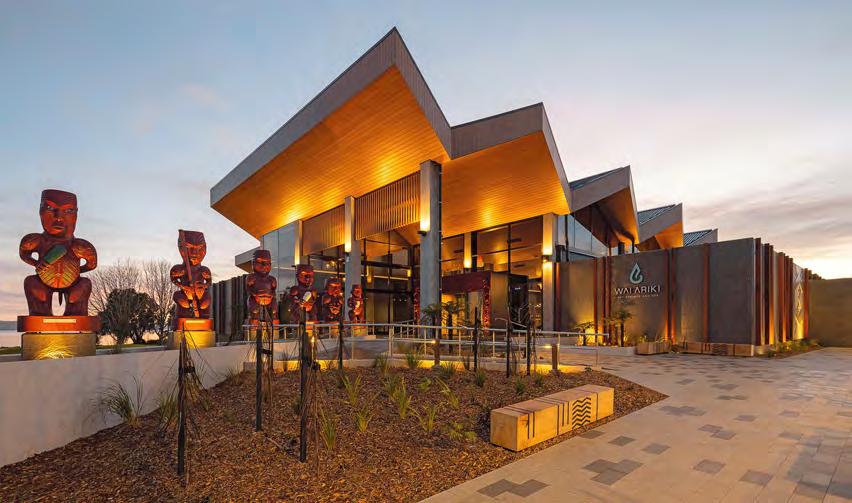
– and especially those that have visited spa destinations overseas – that they see and feel the cultural nuance throughout, and as a result, they feel it is vastly unique to anything they have seen or experienced before.
tricably linked with the physical space, with each drawing from and supporting the other as manuhiri experience Wai Ariki, the indigenous spa treatments, natural mineral waters, and the Ngāti Whakaue story that underpins every part.
“We know from our manuhiri
“This is the feeling that everyone involved has worked so hard to bring together, and the Wai Ariki team have the privilege of being on the frontline to see manuhiri experience it firsthand.”
Architecture and design firm, RCG, is thrilled to see the kaupapa being widely recognised both nationally and internationally.
RCG Director, John Lenihan,
says Wai Ariki was close to his heart from the beginning.
“We were given the wero (challenge), guided by PLHL, to create a culturally, architecturally, experiential and beautiful space, offering manuhiri visiting Wai Ariki a visual and sensory experience like no other.
“The goal was to seamlessly blend Ngāti Whakaue’s rich cultural heritage and healing practices with breathtaking, indigenously driven design. We’re delighted with how people are responding to it and the awards that have already been received, and look forward to showcasing Wai Ariki on the world stage later this year.”
My father’s latest obsession – well he’s had this obsession for about 10 years now and his enthusiasm for it has never waned – is counting the number of passengers on public buses.
His joy is not so much in the counting, but rather in the glee with which he can announce the total count to anyone who will listen. He is interminably delighted to proclaim: “I only need the fingers of one hand to count the passengers most days.”
While we don’t ever discuss it – maybe because he knows I’m a bike person – I fear public spending on cycleways is probably fertile ground for additional frustrated utterances on his part, “… $10million of my tax money spent and you never see a bike on that damn cycle path, pfft!”
My default position is generally diametrically opposed to his on such issues – it feels like the right thing to do to give balance to the universe: If my dad and
Mike Hosking are sitting on the port side of the boat, I feel an automatic inclination to move immediately to starboard – I like to think I provide ballast to the zeitgeist.
Though I am reluctant to admit it, sometimes I worry that maybe he has a point. I sat with him in a restaurant in Auckland earlier in the week. We had a window seat on a main road. His total count for the lunch: 13 buses in one hour 11 minutes with an average of 3.5 passengers per bus (not including OUT OF SERVICE and DRIVER IN TRAINING participants).
I rolled my eyes – “Dad, we’re here for lunch, not train[bus] spotting.”
Yet there was something quite disquieting about his stats.
Fast-forward 48 hours I found myself seated mid-bus on the number five from the Mount to Tauranga. Upon arrival I realised I had been the only passenger for the entire journey.
To an extent these observa-
tions may be outliers. Try catching a bus in central Auckland at 5pm, or in front of Tauranga Girls College at 3.30pm on a weekday –the average patronage then starts to look a lot healthier.
And therein lies a predicament: we – well most of us anyway – want public transport to be readily available and well patronised in New Zealand. But peak demand, by definition, is only at ‘peak’ times, meaning we are stuck with over capacity at other ‘off-peak’ times – they’re the ones my dad knows all about.
The bus operators aren’t stupid, they’re generally astute commercial managers.
Civil servants, for the most part, are not stupid either – they are constantly in the public-eye administering big budgets, managing valuable assets and organising significant human resource rosters.
Neither group – the bus operators nor the local body authorities – wants to see near-empty
buses on our streets. Their promotions, pricing and planning are all aimed at overcoming the low patronage.
Build it and they will come, as a philosophy, seems to have fallen short when it comes to urban bus networks in much of the country.
Why not go bespoke then, with a network of small-footprint, short-route mini-buses?
While these may be cheaper to purchase and easier to move, they still have to be driven by someone (for the time-being) who needs to be trained and paid, and the question still remains, “What happens at rush hour?”
The answer lies with us, the commuters; Not with the council or the bus company but with us, the residents.
I sometimes wonder if the bus companies earn more from the ads on the back of the empty buses than from the fares paid by the peak time-users? Maybe that’s the way it should be.
We want a reliable, regular bus

HAVE YOU EVER NOTICED?
BY ALAN NEBEN
service … and we want the bus service to be well-used … so the ball is in our court to use it. They have built it, it is up to us to come. Every journey begins with a single step. Let’s start by aiming to raise that average from 3.5 passengers to 10 passengers per bus in off-peak times – let’s face it, half passengers are really no use to anyone.
Alan Neben is a Mount Maunganui local and experienced New Zealand publisher. His columns provide a light-hearted perspective on social changes effecting New Zealanders.
In today’s tough economic environment, businesses are struggling with rising operational costs and a pressing need for sustainable practices. In response, commercial property fund management business PMG Funds is prioritising the search for innovative funding solutions for economic and environmental sustainability initiatives. This approach provides significant benefits to both tenants and investors.
Our sustainability strategy focuses on cost-effective sustainability initiatives. We are committed to reducing the operational costs and carbon footprints of the properties we manage. Last year, we signed a significant partnership agreement with Sunergise, an award-winning solar provider, with the aim of providing renewable energy to buildings within our funds by installing solar power solutions.
This initiative sees Sunergise handle the design, installation, and ongoing maintenance of

solar panels at no cost to PMG, its tenants, or investors.
The initial phase of our partnership involved installing solar panels on three of our properties – one early childhood education centre and two office buildings in the North Island, with the fourth installation set to begin soon at Truman Lane, Mount Maunganui, which our tenant Tui Garden Products, occupies.
Our collaboration with Sunergise demonstrates how we can simultaneously deliver on our promise to be the property part-
ner of choice for our tenants and investors.
For our tenants, it provides cheaper and cleaner power; for our investors, it means no capital outlay is required from the funds they are invested in to install the green energy sources today’s tenants are demanding. Additionally, investors will see lasting benefits when tenants renew their leases and opt to remain in our buildings for an extended period.
Beyond the partnership with Sunergise, we are actively involved in other low-cost sustainability initiatives. We have partnered with ChargeNet to install electric vehicle (EV) chargers at our properties, including Bethlehem Town Centre.
Here, we have added an additional revenue stream by leasing exclusive parking bays to ChargeNet for EV chargers, requiring no capital investment from PMG. This initiative, which launched in July, not only supports sustainable transport but also meets the growing demand for EV infrastructure in the region.
Additionally, we are proactive in waste management, measuring and reporting on all waste
streams with the intent to divert as much waste from landfills as possible.
We work with our tenants to support them in their sustainability journey and conduct waste education sessions.
These sessions aim to promote sustainable waste practices, further embedding environmental consciousness within the business operations of PMG’s tenants. Investing in sustainability is not just about immediate cost savings; it’s about building resilience and preparing for the future.
Although the current economic climate is tough, the long-term benefits of sustainable practices are significant.
Efforts to decarbonise real estate are critical in mitigating the effects of climate change, and resilience measures are essential to ensure buildings can withstand these changes.
By implementing the right sustainability measures at the right time, property owners can minimise the impact of climate-related risks on their assets’ value
and income generation.
For many businesses, this translates into reduced disruptions and enhanced business operations.
Moreover, developing sustainable and inclusive spaces positions businesses to thrive in a future where environmental considerations are paramount. Our strategic partnerships and sustainability initiatives illustrate how companies can navigate economic challenges by investing in green solutions.
Through our collaboration with Sunergise and ChargeNet, we are reducing operational costs, retaining tenants, and delivering regular returns and growth in value over time to investors – all while contributing to a more sustainable future.
As the focus on sustainability continues to grow for occupiers and tenants – we acknowledge our opportunity to play a prominent role in leading the sector.
Simi Mukherjee is Head of Sustainability and Facilities Management at PMG Funds. She can be reached on simi@pmgfunds.co.nz
Disc golf enthusiasts are invited to ‘putt’ their skills to the test at a new ninehole course at TECT Park.
Disc golf, or frisbee golf, is played much like ball golf, but players throw discs instead of hitting a ball. The target is a metal basket, and the aim is to get the disc/frisbee into the basket in as few shots as possible.
Designed and built by Haydn Shore, of Disc Shop Disc Golf, the course is free to use and can be found at the back of the freedom camping area. Normal frisbees can be used, however proper discs are recommended, which
can be found at most sports stores.
“We’re excited to bring disc golf to the park, adding a new activity for people of all skill levels to enjoy. Whether you’re a seasoned player or new to the sport, this nine-hole course is a great excuse to get outdoors in a beautiful setting and have fun with whānau and friends,” says TECT park ranger Emily Bykar.
Growing in popularity, there are now more than 70 disc golf courses in Aotearoa, New Zealand. The new course at TECT Park is the second for the Western Bay of Plenty – there is also a
full, 27-basket course at McLaren Falls.
Last year Council sought feedback from the community about what new activities people would like to see at the park. More than 690 people shared their ideas, and Council is now in the process of finalising a plan for the park’s future.
“As we continue to develop TECT Park, sustainability, education, and cultural enrichment remain at the forefront of our plans. Disc golf aligns well with these values, offering a low-impact activity for people of all ages to enjoy,” says Emily.
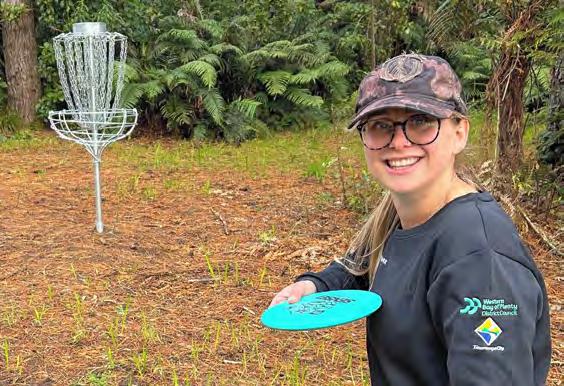
EmilyBykar,TECTparkranger







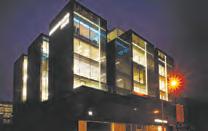



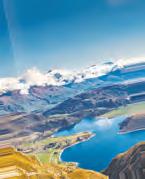
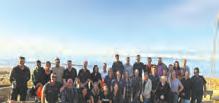
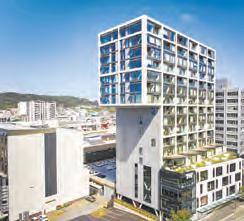
New Zealand companies who believe they can’t afford to operate sustainably in today’s tough economy are being offered help to tackle one of the biggest challenges they face – unclear Return on Investment (ROI).
Sustainable Brands Aotearoa
will mark its New Zealand launch by holding a oneday symposium in Tauranga on August 15th. Two remarkable international speakers, Daniel Aronson and Dr Leyla Acaroglu, will headline the event, which is designed to help businesses challenge the status quo and make positive social and environmental change.
“Companies often believe that they can’t afford to do the right thing by people and the planet, but the opposite is true,” Aronson explains. “Values can – and should – be a significant part of your business success. The truth is most industries, and most of your competitors, are doing more on sustainability. If you don’t, you’ll fall behind and your competitors will reap the benefits.”
According to IBM’s Institute of Business Value 2022 CEO Study, more than 80% of CEOs said sustainability investments would drive better business results.
Yet more than half of the 3000 CEOs surveyed ranked “unclear economic benefits” as the biggest roadblock to achieving their
objectives.
Sustainable Brands Aotearoa is part of a global network of brand innovators throughout Europe, Asia, North and South America who are working to reshape the future of commerce.
The New Zealand symposium is designed to help CEOs, CFOs, human resource, finance, investor relations and sustainability professionals to ‘see’ the true value that sustainable business practices can offer.
Aronson is a leading author (‘Value of Values’) and guest lecturer at Harvard Business School and MIT Sloan’s Sustainability Lab who has helped companies identify and quantify over $2 billion in sustainability-driven business value.
He says as an export nation, New Zealand businesses are already impacted by regulatory and global brand requirements which reflect the values of global consumers. “This can only accelerate the changes in how customers buy and, therefore, the importance of sustainability criteria.”
Local climate change impacts, such as Cyclone Gabrielle, is fur-
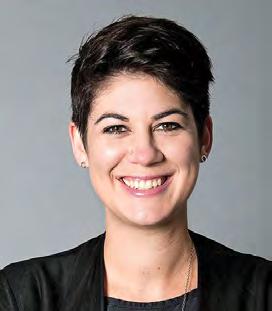
ther evidence that businesses must take positive action now to look after our planet for future generations.
His workshop will explain how the value of sustainability is often ‘submerged’ and goes unnoticed – leading companies to vastly underestimate the positive impact it has on business. “Submerged value can be quantified. But right now it’s normally either missed or not quantified, which effectively gives it a value of zero – the only value it can’t possibly have.”
Aronson says helping businesses overcome the ROI bar-
rier they face will unleash more action and ultimately lead to more value for both them and society in general.
Fellow guest speaker, Dr Leyla Acaroglu, will also inspire and help equip New Zealand business leaders with the tools to take immediate action. As a leading sustainability strategist, her TED talk on how to rethink environmental folklore has almost 1.5 million views and she was named a UNEP Champion of the Earth in 2016 for her work in advancing science and innovation for sustainability.
Acaroglu is a product designer by trade and will share her firsthand experience of working with some of the world’s biggest companies as they embrace the transition to a circular economy. Her presentation will explore current best practice and the regulatory shifts that are driving change such as the new ISO Circular Economy standards which are now in play.
“My circular redesign workshop will enable business leaders to envisage their products and services as part of the global
transformation to a circular and regenerative economy,” she explains. “By exploring the full systems impacts and looking at the benefits of circular business models, the workshop will ensure that New Zealand businesses are leading the way when it comes to circular materials, products and services.”
Sustainable Brands Aotearoa spokesperson Lewis Patterson says in the face of pressing global challenges, businesses hold immense potential to drive positive change. “Attending SB Aotearoa 2024 marks the start of a transformational journey towards initiating and implementing sustainable business practices that prioritise long-term value creation, resilience and well-being for current and future generations,” he says.
“By focusing on the intersection of what people want, what brands can deliver, and what the world needs, SB Aotearoa 2024 aims to elevate business case models that empower businesses to drive actual change through sustainable practices, innovation and responsible leadership.”
One of Te Puke’s oldest professional service firms, Bennetts Proactive, has embarked on a new chapter at a time when Bay businesses need a closer relationship with their accountants than ever before.
Experienced senior chartered accountant Maria Livingstone recently re-joined the team as a new Associate, almost two decades after she originally began working there as a university graduate.
“Bennetts Proactive has always been a wonderful firm to work for. I’m excited to return and be given the opportunity to lead the team alongside Lance Ewens and Amanda Hutchings,” she says.
“Over the past decade I’ve gained a huge amount of commercial experience across all sectors including construction, property development, retail and manufacturing. I’ll now be using that knowledge and expertise to benefit our firm’s wonderful clients who range from multi-million horticultural operations through to Bay of Plenty-wide SMEs and mum and dad property investors.”
While based in Te Puke, Ben-
netts Proactive’s clients can be found throughout the region as many prefer the firm’s personalised and responsive service, easy access and affordable fees while still enjoying all the benefits the latest accountancy software and technology can offer.
“Our firm was one of the early adopters of Xero and we can certainly match the expertise and services offered by big-city accountancy firms,” Maria says. “Our team are exceptionally good at what they do, and can help people with their annual tax returns, financial statements and GST compliance as well as quarterly reporting, cashflow reporting, budgeting, business appraisals, succession planning, trust administration and much more.”
Today’s tight economy means it’s imperative for businesses to work alongside their accountants to trouble-shoot any problems before they arise, Maria says.
“Working regularly with your accountant means you’ll always know where you’re at, instead of muddling through to the end of financial year and then discovering a problem. A lot of sectors are struggling at the moment. So it’s important to manage cash flow and avoid getting into crisis situations. Early intervention is key, which is why you should be leveraging your accountant’s knowledge and consulting with them closely right now.”
Maria says there’s often a perception that technology and software does all your accounting for you, which simply isn’t true. “The data is only as good as the person entering it. There’s still a lot of nuance when it comes to applying tax law and banks certainly want to see financial statements that have been reviewed by accountants to make sure they’re sensible and accurate. There’s also a wealth of advice
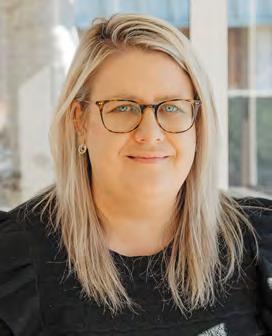
we can provide on business planning, strategies for growth and succession. Artificial intelligence cannot sympathise or understand the unique issues you’re facing on the ground.
“Tax and property law is continuing to evolve and catch people out, so it’s better to ask questions at the outset when setting up a business and spend $500 to get it right than spend $5000 down the track trying to fix up a mistake,” she explains.
“I’ve helped clients through a lot of tough situations and emotions do run high when your live-
lihood is on the line. So it’s important to have a trusted accountant who can relate to you and your business. To me, accountancy is more than just numbers. It’s about building relationships with people and being that vital sounding board to help you get through those hard times so your business can still grow and thrive.”
Bennetts Proactive was founded in the mid-1950s and was originally called Earp and Earp. Current owner Lance Ewens joined the business 40 years ago and says Maria’s arrival was “the easiest hire I’ve ever made”.
“We’ve morphed a lot of times over the years but we’ve stood the test of time thanks to the excellent service we provide, primarily to the horticulture, dairy and livestock industry. But today we provide accountancy services to a wide range of SMEs and sole traders across every industry you can imagine. And with Maria now on board, I know we are very well-positioned for the future. She knows her stuff, and brings a lot of new ideas and energy which will ultimately benefit our clients and our local economy.”
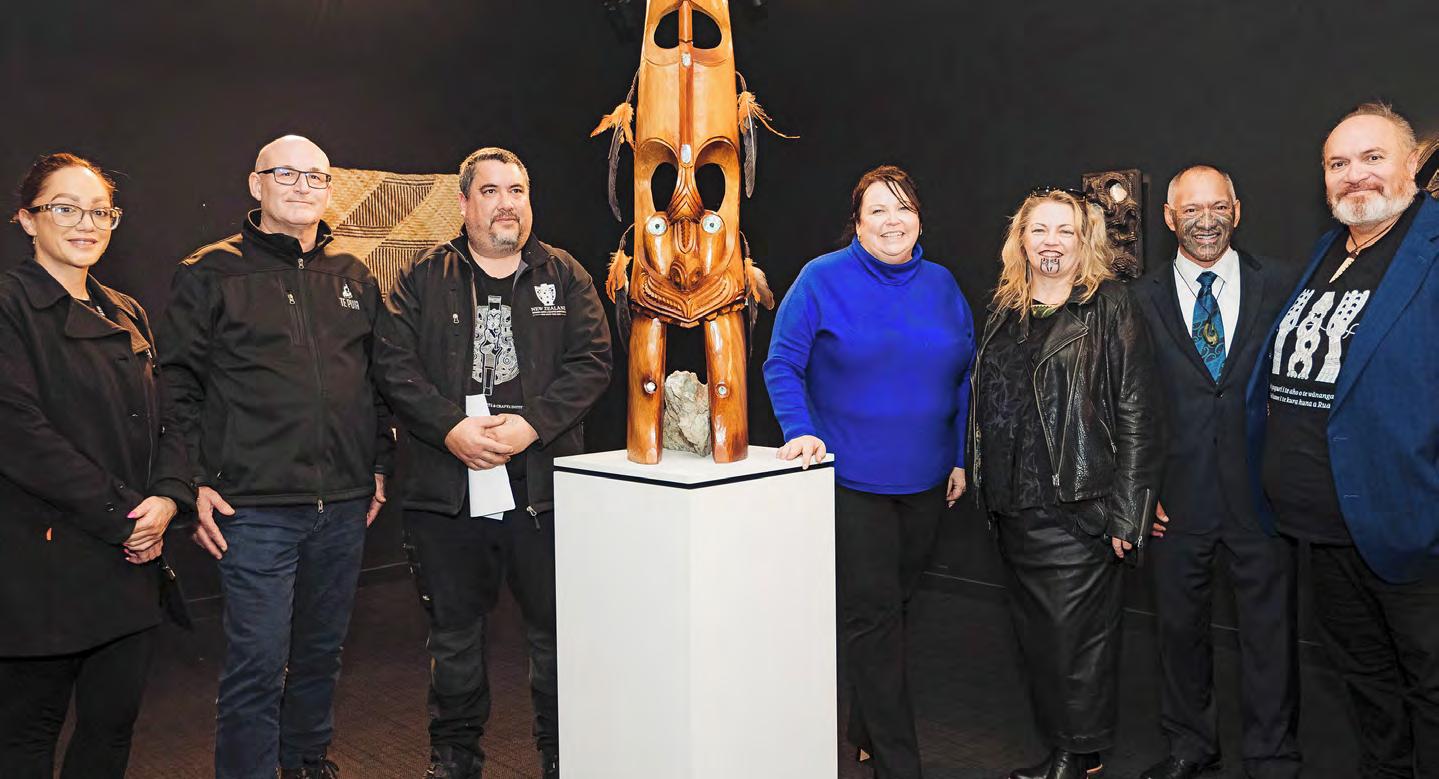
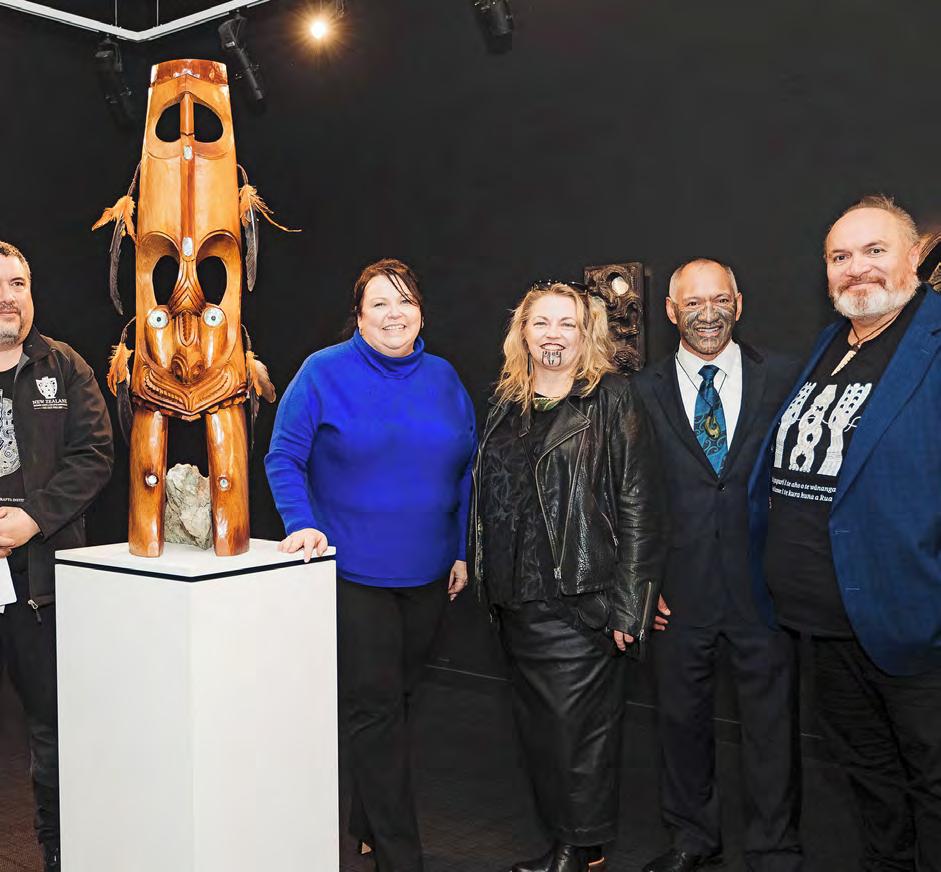
TheblessingofWakaPutangaat ĀhuaGalleryatTePuia|NewZealandMāoriArtsandCraftsInstitute.L–R:JessieEmery,TimCossar,HohepaPeni,LisaHopkins,NgahihiBidois,CarolynBidois,SeanMarsh.
A Tauihu carving was blessed and gifted to Business Events Industry Aotearoa in June at Te Puia | New Zealand Māori Arts and Crafts Institute.
Rotorua was hosting MEETINGS organised by Business Events Industry Aotearoa (BEIA) – the biggest national trade show in Aotearoa New Zealand for the business events industry, where international buyers come together to discuss new business opportunities.
BEIA chief executive Lisa Hopkins said it was an incredibly humbling moment to see the taonga unveiled.
“We feel extremely privileged, and we also accept the responsibility and understand the importance of what has just happened. It’s a beautiful piece - it’s a new member of the team and I feel quite overwhelmed by the manaaki we’ve been shown,” she said.
Hopkins explained that the genesis of this moment came together over a cup of coffee last year when BEIA was talking about bringing MEETINGS to Rotorua and what that might look like.
“We thought, wouldn’t it be great to have a taonga from the New Zealand Māori Arts and Crafts Institute Te Wānanga Whakairo Rākau (National School of Wood Carving) that could be put on display at our annual events, and which could be part of the BEIA organisation.”
New Zealand Māori Arts and Crafts Institute (NZMACI) Pouako Whakairo Rākau (wood carving tutor) Hohepa Peni led the carving of the piece titled Waka Putanga, also working on it with tauira (students). He explained that a Tauihu is the front-end prow of a waka in miniature form which represents people coming from overseas for MEETINGS for an emergence of ideas.
The rākau is from a 3,000-year-old log of kauri from Tā (Sir) Hekenukumai Busby, a Te Tai Tokerau elder who led the revival of traditional Māori navigation and ocean voyaging skills. This same log of kauri was also used to carve a 10-metre waka maumahara at the World Expo in Shanghai in 2019 as part of the NZMACI Tuku Iho Living Legacy Exhibition.
Peni says the tauihu has a tenison morton join cut at the bottom which is referred to as the haumi kokomo – a specific join to extend the waka and make it longer.
“In a different context – haumi means ‘to join’ as a kaupapa (purpose) – it reflects how we seek to join ideas at this MEETINGS event, with the connecting of business,” said Peni.
“The two stylised figures represent
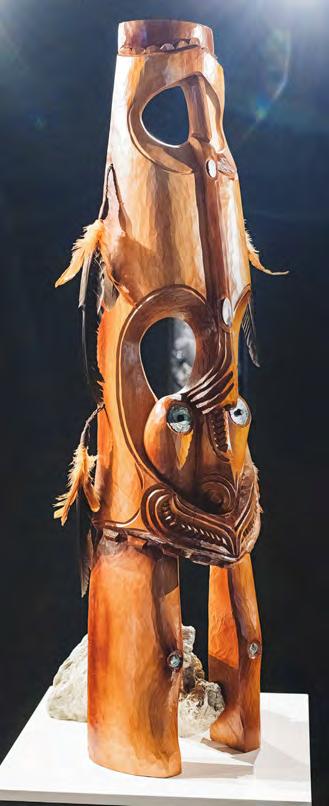
ATauihucarving–WakaPutanga–wasblessed andgiftedtoBusinessEventsIndustryAotearoa yesterdayattheNewZealandMāoriArtsand Crafts Institute.
tangata ora (the living) – the people who will be at MEETINGS and the people of BEIA.
“This form is also in putanga style, which means ‘to emerge’, to step out. We’ve also tried to keep this culturally accessible to all and we have contemporised the piece with hollowing out techniques which are more sculptural, to show off the rākau – it’s not over designed because it’s beautiful kauri,” he said.
“The pāua (abalone) shell inlays are an acknowledgement of travellers converging like rivers or seas.
“The kura (feathers) represent the dreams everyone brings for the future. At MEETINGS, attendees are looking for connections and outcomes to make their dreams become a reality. The feathers in an indigenous context connect us back with our tūpuna (ancestors),” Peni explained.
Waka Putanga is now a feature at the entrance of the Energy Events Centre where MEETINGS is held over the next two days.
Whano, whano! Haramai te Toki! Haumi ē!, hui ē!
Taiki ē!
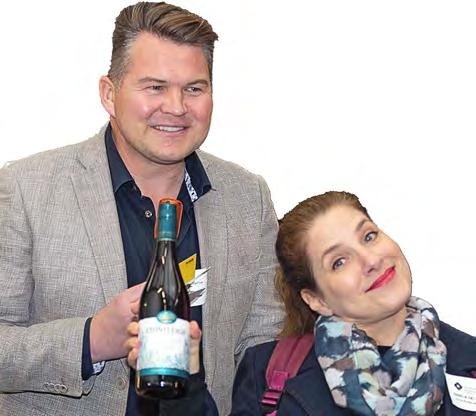
Tauranga Business Chamber’s July BA5
Host: Toi-Ohomai. Location: Toi-Ohomai, Windermere Campus
Date: Wednesday, 3 July 2024
Photography: Salina Galvan Photography
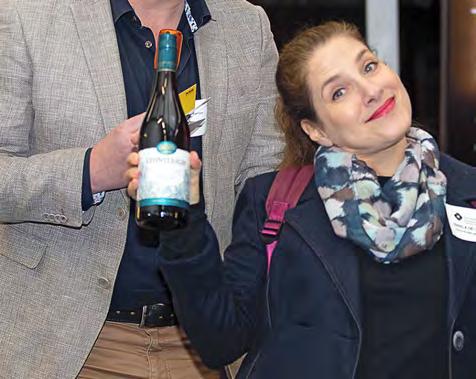
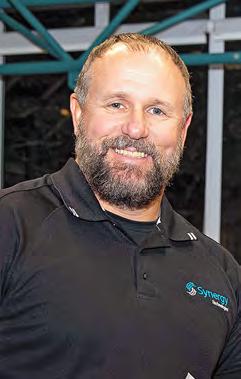
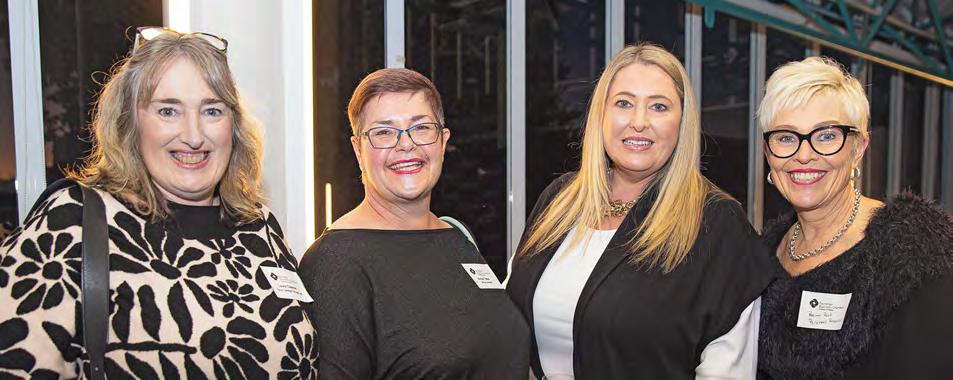

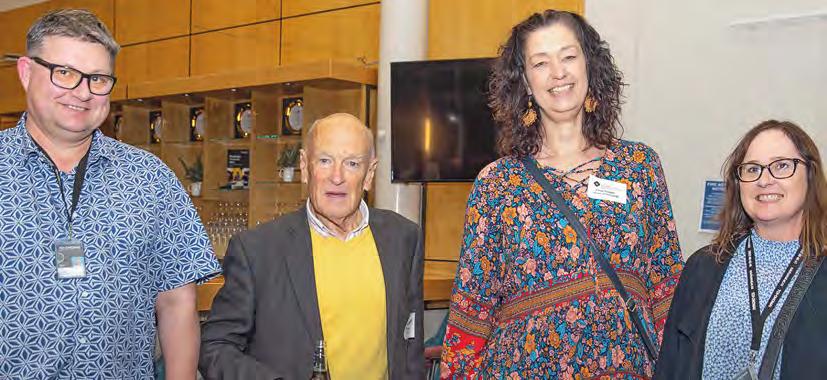
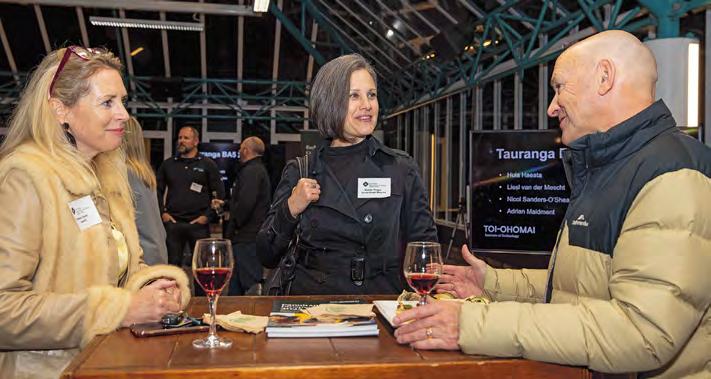
ONE FIVE EIGHT TWO FOUR SIX SEVEN NINE THREE
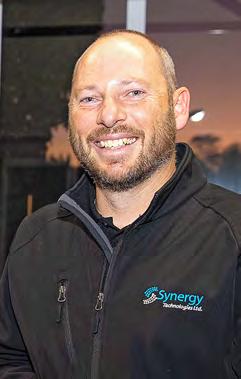
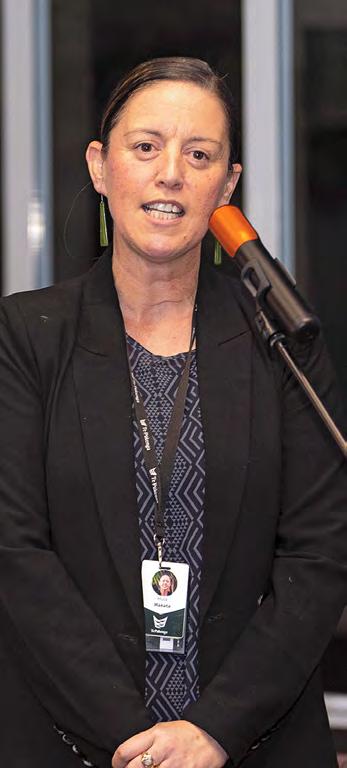
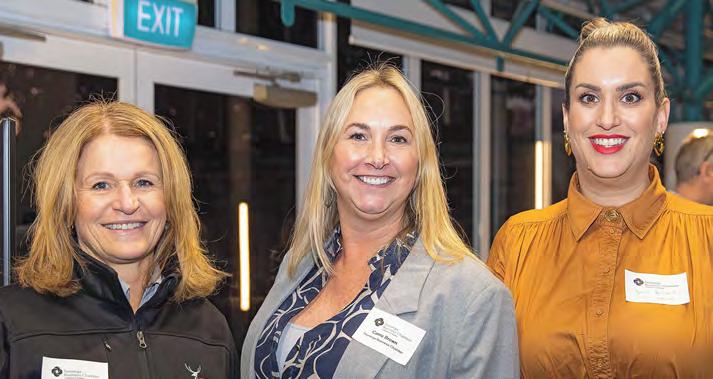
ONEMattCowley(TaurangaBusinessChamber)&GiselaDeCastro(ZuccaBooksandProduction). TWOLauraClayson(SoulDesignGroupLtd),SoniaTibble(BecaLimited),RheaClune&RaewynPeck (PersonnelResources). THREEDavidHodge(SynergyTechnologiesLtd). FOURConradKuriger(KurigerBuilders),JasonFox(QuantumAssetFinance),MichaelLlewellyn(BancorpCorporateFinance) &HugovanCingel(HJMediaNZ). FIVEAdrianMaidment(Toi-Ohomai),PeterMcKinlay(ThinkTank),ChrisDuggan(HouseofScience)&NicolSanders-O’Shea(Toi-Ohomai). SIXJoshuaMartin(Synergy TechnologiesLtd). SEVEN HuiaHaeata(Toi-Ohomai). EIGHTSimoneDavey(TalentID),NinetteKruger(NinetteKrugerMetalArt)&KeithWoodcock(StratusBlueLimited). NINE JoanneRouse(Black StagCoffee),CarrieBrown(TaurangaBusinessChamber)&JessicaBarnett(Toi-Ohomai).
BBN’s guide to new people and new roles across business in the Bay To feature in New Appointments email us at new.appointments@bopbusinessnews.co.nz
Copeland Ashcroft is pleased to announce the addition of Alice Tipoki-Lawton as Projects and Marketing Manager to their team.
Based in Tauranga, Alice will be focussed on optimising business operations and driving the firm’s strategic objectives. Alice is excited to take on a leadership role in the firm and looks forward to utilising her knowledge and skills to achieve this.
Copeland Ashcroft operates from offices in Auckland, Tauranga, Hastings, Christchurch, Timaru, Queenstown, Dunedin and
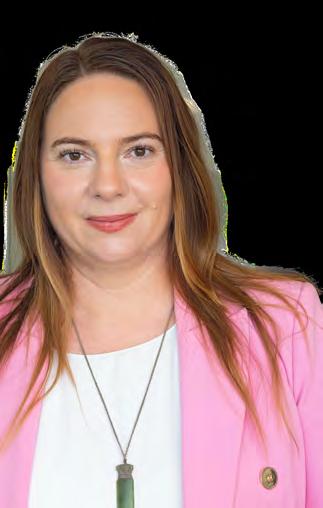
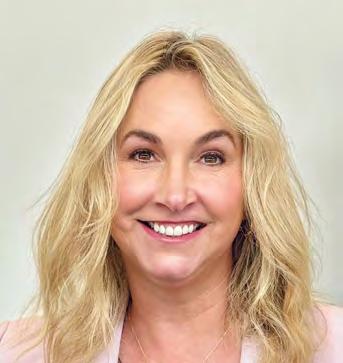

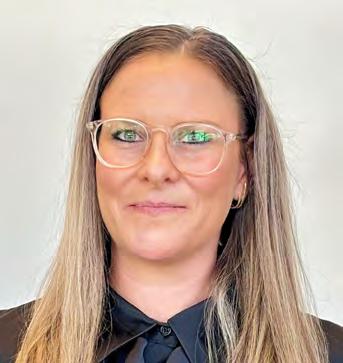

Carrie Brown has been appointed as Communications and Events Manager. Carrie brings a wealth of experience in media, communications and non-scripted television, having worked extensively with high-profile clients across New Zealand and internationally.
In her new role, Carrie will oversee all Chamber communication channels, including the newsletter, website, and social media.
As Head of Content, she will keep our wider audience up to date with the latest trends, insights, and changes impacting local business success.
Carrie will also be a familiar face at our events, such as Business After 5, Business Women’s Network, the Golf Tournament, and the Business Awards.
Her fresh perspective, innovative ideas, and proven track record in client relationships and project management will be invaluable to the Chamber.
Dimity McNamee has joined the RBP as Western BOP’s Growth Advisor.
Dimity works with businesses of all sizes, from start up to well established, assisting with their future growth and development.
By identifying the gaps and challenges each business faces- whether across marketing, financial forecasting, business planning, and leadership training- she works with owners to build their managerial capability and plans for growth. Her dedication to building trust and driving
results is instrumental in supporting RBP’s commitment to delivering superior value and service to its clients.
Bridget Jenkins, the Chamber’s new Membership Coordinator and Administrator, has over a decade of experience in high-end beauty & fashion retail and brings solid expertise in customer relations and building connections.
Known for her warm and engaging personality, she thrives on putting a smile on people’s faces and ensuring our members enjoy a seamless experience. Bridget is passionate about supporting the Chamber’s business community and is committed to making a positive impact on their membership journey.
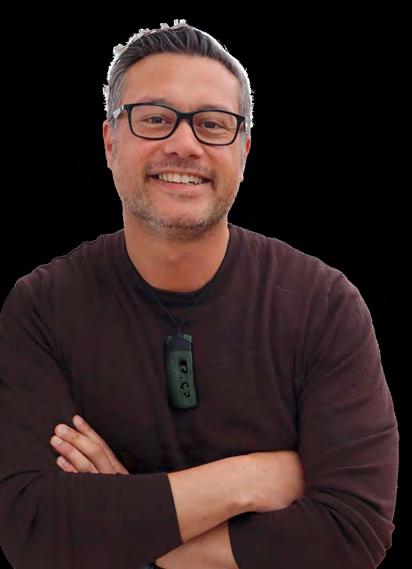
Haydn Marriner has been appointed in the pivotal new role of Brand Development Manager at Tourism Bay of Plenty.
Haydn’s spent the past four years in a similar role at Economic Development Agency RotoruaNZ. He has more than 20 years’ experience in destination management, tourism and marketing and is Chair of BYATA, the Backpacker Youth and Adventure Tourism Association.
Tourism Bay of Plenty general manager Oscar Nathan says he’s thrilled Haydn is joining the team.
“I’m confident he will pursue a strong engagement programme that will enable us to go forward on this journey to create a distinctive place brand that residents and businesses will be proud of.”
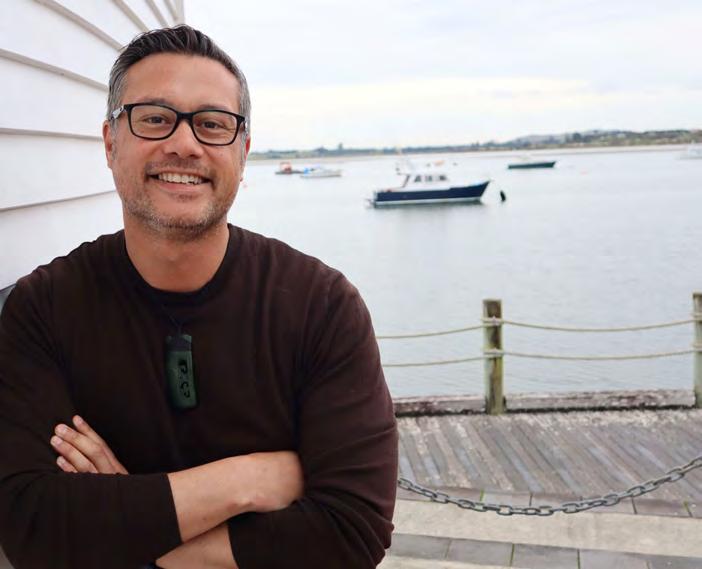

Aaron Middleton joins Cucumber as CTO, bringing over 15 years of experience at the forefront of science, R&D and innovation. With degrees in physics and business administration, Aaron has delivered innovative solutions across industrial domains, including green metals, defence, and more.
His expertise in smart materials, machine-learning, and embedded systems aligns with Cucumber’s mission to drive sustainable innovation. Having worked with SSAB in Scandinavia, Aaron is committed to advancing decision-making technologies.
Raised in a farming environment, he enjoys exploring nature with his three children, believing in the inspiration found in nature’s patterns for creating resilient solutions.
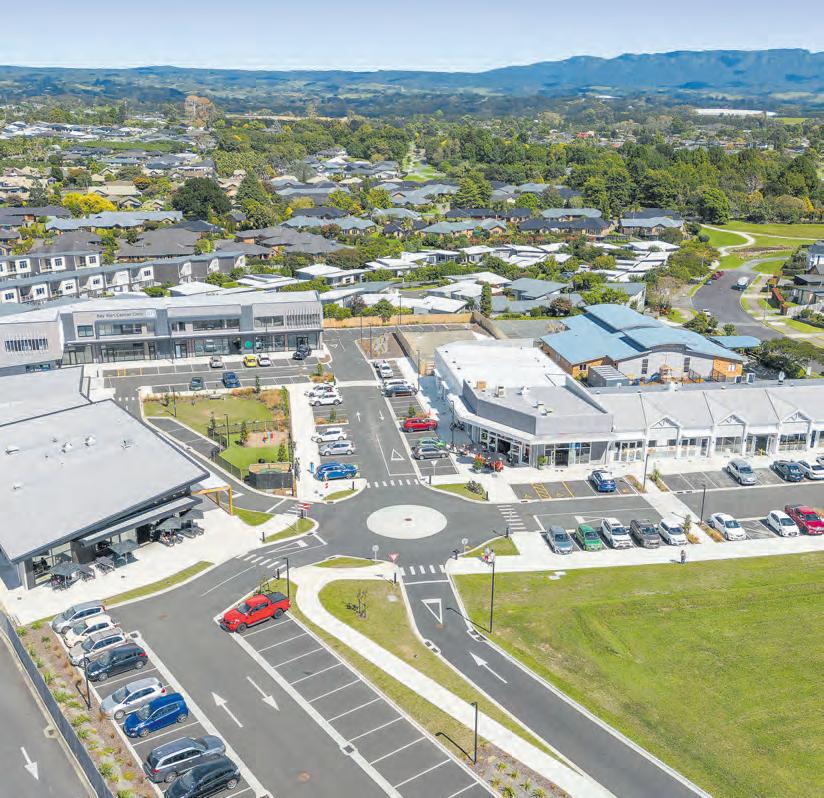
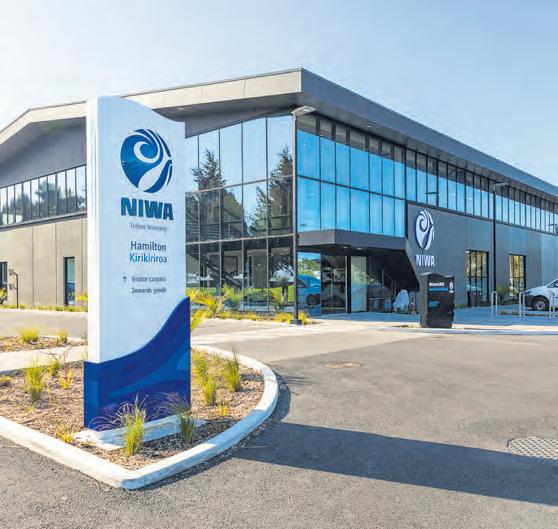

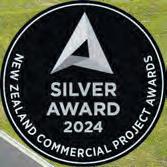
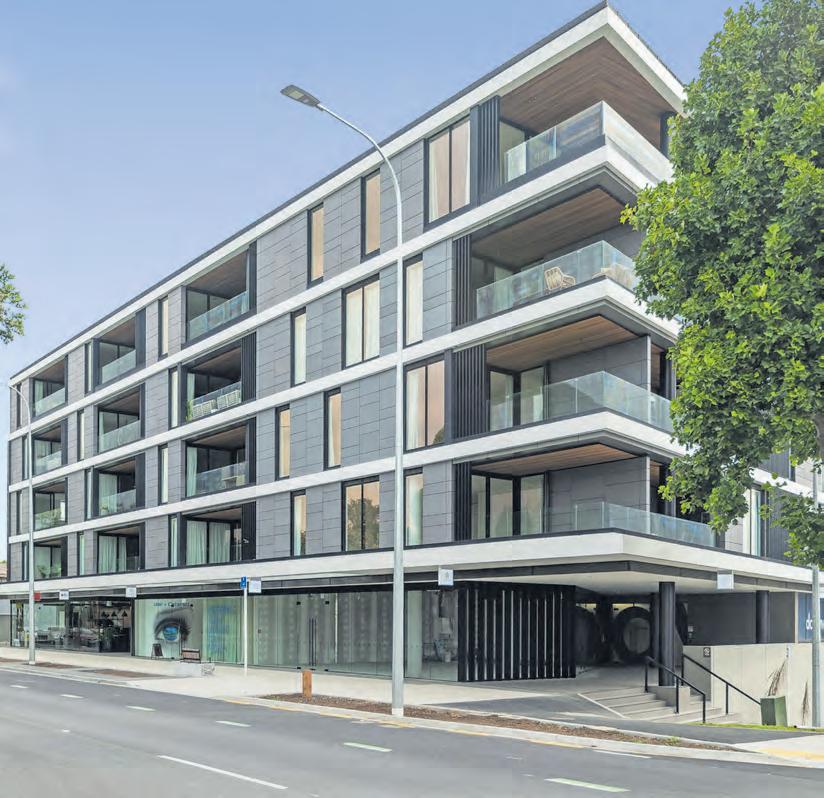
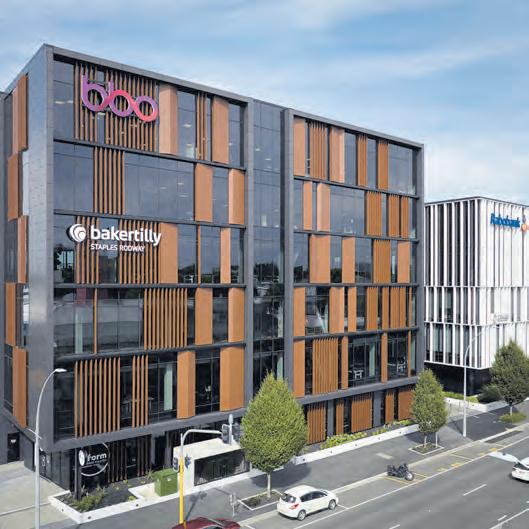
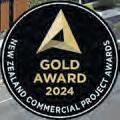
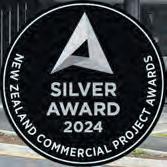

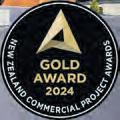
2Golds,3Silvers.
TheNewZealandCommercialProjectAwards,acompetitionwhich showcasesandcelebratesthebestincommercialconstructionfrom aroundthecountry,sawatotalof119entriesfor2024.
TheFosterGroup(Fosters)arecelebratingtwoGoldandthreeSilver awardsacrossfivecategories:commercial,industrial,retail,public andresidential.
GoldwenttoUnionSquare’sBuildingsEandF(commercial),and Convex(industrial).NIWAwonSilverinthepubliccategory,while BayofPlentyprojectsTheVillageOmokoroa(retail)andVantage (residential)werealsoawardedSilver.
WithbothUnionSquareandTheVillageOmokoroabeingFosters’
propertydevelopmentprojects,theawardshighlighttheGroup’s growingstrengthinthisarea.
Itwaspleasingtonotethatsustainabilitywasattheforefrontinthis year’scompetition.
AstatementfromRegisteredMasterBuilders,whorunthenationwide competition,noted:“Thetrendtowardssustainablebuildingpractices reflectsagrowingawarenesswithinthecommercialsectorofthe importanceofenvironmentalstewardship.”
Asconsciousleadersinsustainablebuildingpractice,wetakethatas awintoo.
Gotabuildprojectinmind? GetintouchwithFosterstoday!